British Security Coordination
October 27, 1941- Address for Navy and Total Defense Day
- Franklin D. Roosevelt
http://www.youtube.com/watch?v=YxHTkXjx6wc
October 27, 1941- Address for Navy and Total Defense Day-Franklin D. Roosevelt
http://www.presidency.ucsb.edu/ws/index.php?pid=16030&st=new+world+order&st1=#axzz1NIedOVv5
http://www.presidency.ucsb.edu/ws/index.php?pid=16030&st=new+world+order&st1=#ixzz1NIenCKuQ
"Hitler has often protested that his plans for conquest do not extend
across the Atlantic Ocean. His submarines and raiders prove otherwise. So does
the entire design of his NEW WORLD ORDER, For example, I have in my possession a
secret map made in Germany by Hitler's Government—by the planners of the NEW
WORLD ORDER. - Franklin D. Roosevelt, October 27 1941
For example, I have in my possession a secret map made in Germany by Hitler's
Government—by the planners of the new world order. It is a map of South
America and a part of Central America, as Hitler proposes to reorganize it.
Today in this area there are fourteen separate countries. But the geographical
experts of Berlin have ruthlessly obliterated all existing boundary lines; they
have divided South America into five vassal states, bringing the whole continent
under their domination. And they have also so arranged it that the territory of
one of these new puppet states includes the Republic of Panama and our great
life line—the Panama Canal. That is his plan. It will never go into
effect.
http://bigthink.com/ideas/21302
http://strangemaps.files.wordpress.com/2008/03/sudameriqa.jpg
 BSC Nazi South America Map
BSC Nazi South America Map
The map, however, was a fake. World War II revisionists (not to put too
fine a point on it: those who would have preferred the Nazis to win) claim this
proves that FDR was a war-mongerer, prepared to lie shamelessly in order to drag
the US into war. But in this case, FDR might have been more mongered against
than mongering – the map most probably was a British forgery, not an
American one.
History ISN'T exactly What you THINK it IS...
In 1998 the BSC typescript
(one of only two remaining) was eventually published. To say it fell
stillborn from the press would be an understatement.
Yet here is a book of some 500 pages, written just after the war by former
BSC agents, telling the whole story of Britain's US infiltration in great
detail, recounting all the dirty tricks and the copious and widespread news
manipulation that went on. I think it's fair to say that historians of the
British Secret Services know about BSC and its operations, yet in the wider
world it still remains virtually unheard of.
http://www.amazon.com/British-Security-Coordination-Intelligence-Americas/dp/0756754690/ref=sr_1_2?ie=UTF8&s=books&qid=1306264003&sr=1-2
British Security Coordination: The Secret History of British Intelligence in
the Americas, 1940-45 [Unknown Binding]
Unknown Binding: 536 pages
Publisher: Diane Pub. (1998)
Language: English
ISBN-10: 0756754690
ISBN-13: 978-0756754693
Roosevelt even cited it in a powerful pro-war, anti-Nazi speech on October
27 1941: "This map makes clear the Nazi design," Roosevelt
declaimed, "not only against South America but against the United States
as well."
http://www.dianepublishing.net/aboutus.asp
Publisher: Diane Pub. (1998)
Diane Publishing - 20th Anniversary
We distribute the most important documents and reports produced by all three
branches of the U.S. government -- executive, congressional and judicial.
Our inventory of over 25,000 documents is especially strong in the areas of
defense, law enforcement, business, agriculture, natural disasters, education,
the environment, energy, housing, intelligence agencies, and medicine and
health. All reports are printed on demand, and are kept in print forever.
We also distribute over 7,000 new, but out-of-print, non-fiction books from
publishers worldwide. Three prestigious societies -- the American Philosophical
Society, the Historical Society of Pennsylvania, and The Library Company of
Philadelphia -- have entrusted their warehousing and fulfillment to us.
see: Churchill
danced after hearing that Americans were slaughtered at Pearl Harbor
The BSC in 1940-1941
Webster
G. Tarpley Debunks Pearl Harbor Myths (And British Spy Ring EXPOSED)
In
1969, Rockefeller Official Said US Would Be De-industrialized
British Security
Coordination Spy Ring in the U.S. prior to Pearl Harbor
http://www.guardian.co.uk/uk/2006/aug/19/military.secondworldwar
The secret persuaders - The Guardian, Saturday 19 August 2006
It was 1940, the Nazis were in the ascendant, the Blitz at its deadliest, and
Britain's last hope was to bring a reluctant United States into the war. So it
was that the largest covert operation in UK history was launched. William Boyd
sheds light on a forgotten spy ring William Boyd
...
However, one of ...
BSC's most successful
operations originated in South America and illustrates the clandestine ability
it had to influence even the most powerful. The aim was to suggest that Hitler's
ambitions extended across the Atlantic. In October 1941, a map was stolen from a
German courier's bag in Buenos Aires. The map purported to show a South America
divided into five new states - Gaus, each with their own Gauleiter - one of
which, Neuspanien, included Panama and "America's lifeline" the Panama
Canal.
In addition, the map detailed Lufthansa routes from Europe to and across South
America, extending into Panama and Mexico. The inference was obvious: watch out,
America, Hitler will be at your southern border soon. The map was taken as
entirely credible and
Roosevelt even cited it in a powerful pro-war, anti-Nazi speech on October 27
1941: "This map makes clear the Nazi design," Roosevelt declaimed,
"not only against South America but against the United States as
well."
Also see the IPR and the Sorge Spy ring... The BSC in
1940-1941
Webster
G. Tarpley Debunks Pearl
Harbor Myths (Amongst Other Things)
British Security Coordination Spy Ring in the U.S. prior to Pearl Harbor
http://www.guardian.co.uk/uk/2006/aug/19/military.secondworldwar
The secret persuaders
It was 1940, the Nazis were in the ascendant, the Blitz at its deadliest, and
Britain's last hope was to bring a reluctant United States into the war. So it
was that the largest covert operation in UK history was launched. William
Boyd sheds light on a forgotten spy ring William Boyd
The Guardian, Saturday 19 August 2006
"British Security Coordination". The phrase is bland, almost
defiantly ordinary, depicting perhaps some sub-committee of a minor department
in a lowly Whitehall ministry. In fact BSC, as it was generally known, represented
one of the largest covert operations in British spying history; a covert
operation, moreover, that was run not in Occupied France, nor in the Soviet
Union during the cold war, but in the US, our putative ally, during 1940 and
1941, before Pearl Harbor and the US's eventual participation in the war in
Europe against Nazi Germany.
When Winston Churchill became prime minister in May 1940, he realised
immediately - if he had not realised before - that he had to achieve one thing
in order to ensure that Britain was not defeated by Hitler's Germany: he had
to enlist the US as Britain's ally. With the US alongside Britain, Hitler
would be defeated - eventually. Without the US (Russia was neutral at the time),
the future looked unbearably bleak. Roosevelt, as president, was predisposed to
help - after a fashion and for cash on delivery - but the situation in America
was overwhelmingly isolationist. One easily forgets this, in the era of our
much-vaunted, so-called "special relationship", but at the nadir of
Britain's fortunes, polls in the US still showed that 80% of Americans were
against joining the war in Europe. Anglophobia was widespread and the US
Congress was violently opposed to any form of intervention.
After the fall of France in June 1940, Britain's position became even weaker -
it was assumed that British capitulation was simply a matter of time; why join
the side of a doomed loser, ran the argument in the US. Roosevelt's hands were
therefore firmly tied. Much as he might have liked to help Britain (and this, I
feel, is a moot point: just how enthusiastic was FDR himself?) he dared not risk
alienating Congress - and he had a presidential election looming that he did not
want to lose. To go to the country on a "Join the war in Europe"
ticket would have been electoral suicide. He had to be very pragmatic indeed -
and there was no greater pragmatist than FDR.
All the same, Churchill's task, as he himself saw it, was clear: somehow, in
some way, the great mass of the population of the US had to be persuaded that it
was in their interests to join the war in Europe, that to sit on the sidelines
was in some way un-American. And so British Security Coordination came into
being.
BSC was set up by a Canadian entrepreneur called William Stephenson,
working on behalf of the British Secret Intelligence Services (SIS).
An office was opened in the Rockefeller Centre in Manhattan with the discreet
compliance of Roosevelt and J Edgar Hoover of the FBI. But nobody on the
American side of the fence knew what BSC's full agenda was nor, indeed, what
would be the massive scale of its operations.
What eventually occurred as 1940 became 1941 was that BSC became a huge
secret agency of nationwide news manipulation and black propaganda.
Pro-British and anti-German stories were planted in American newspapers and
broadcast on American radio stations, and simultaneously a campaign of
harassment and denigration was set in motion against those organisations
perceived to be pro-Nazi or virulently isolationist (such as the notoriously
anti-British America First Committee - it had more than a million paid-up
members).
Stephenson called his methods "political warfare", but the
remarkable fact about BSC was that no one had ever tried to achieve such a level
of "spin", as we would call it today, on such a vast and pervasive
scale in another country. The aim was to change the minds of an entire
population: to make the people of America think that joining the war in
Europe was a "good thing" and thereby free Roosevelt to act
without fear of censure from Congress or at the polls in an election.
BSC's media reach was extensive: it included such eminent American columnists as
Walter Winchell and Drew Pearson, and influenced coverage in
newspapers such as the Herald Tribune, the New York Post and the Baltimore
Sun. BSC effectively ran its own radio station, WRUL, and a press
agency, the Overseas News Agency (ONA), feeding stories to the media as
they required from foreign datelines to disguise their provenance. WRUL would
broadcast a story from ONA and it thus became a US "source" suitable
for further dissemination, even though it had arrived there via BSC agents. It
would then be legitimately picked up by other radio stations and newspapers, and
relayed to listeners and readers as fact. The story would spread
exponentially and nobody suspected this was all emanating from three floors of
the Rockefeller Centre. BSC took enormous pains to ensure its propaganda was
circulated and consumed as bona fide news reporting. To this degree its
operations were 100% successful: they were never rumbled.
Nobody really knows how many people ended up working for BSC - as agents or
sub-agents or sub-sub-agents - although I have seen the figure mentioned of up
to 3,000. Certainly at the height of its operations in late 1941 there were many
hundreds of agents and many hundreds of fellow travellers (enough finally
to stir the suspicions of Hoover, for one). Three thousand British agents
spreading propaganda and mayhem in a staunchly anti-war America. It almost
defies belief. Try to imagine a CIA office in Oxford Street with 3,000 US
operatives working in a similar way. The idea would be incredible - but it was
happening in America in 1940 and 1941, and the organisation grew and grew.
From a novelist's point of view, to discover such a forgotten corner of
20th-century history is a wonderful and unique gift. I had long wanted to write
a novel about a spy, a woman spy in fact, but to have her spying in America -
rather than in Russia or Germany or Occupied France - seemed an irresistible
bonus. The more I investigated BSC's activities, the more intrigued I became.
Some of BSC's schemes verged on the absurd; some were highly sophisticated media
manipulation.
BSC invented a game called "Vik", described as "a fascinating
new pastime for lovers of democracy". Printed booklets described up to 500
ways of harassing and annoying Nazi sympathisers. Players of Vik were
encouraged to ring up their targets at all hours of the night and hang up. Dead
rats could be put in water tanks, air could be let out of the subject's car
tyres, anonymous deliveries could be made to his house and so on. In the summer
of 1941, BSC sent a sham Hungarian astrologer to the US called Louis de Wohl. At
a press conference De Wohl said he had been studying Hitler's astrological chart
and could see nothing but disaster ahead for the German dictator. De Wohl became
a minor celebrity and went on tour through the US, issuing similar dire
prognostications about Hitler and his allies. De Wohl's wholly bogus predictions
were widely published.
However, one of BSC's most successful operations originated in South America and
illustrates the clandestine ability it had to influence even the most powerful. The
aim was to suggest that Hitler's ambitions extended across the Atlantic. In
October 1941, a map was stolen from a German courier's bag in Buenos Aires. The
map purported to show a South America divided into five new states - Gaus, each
with their own Gauleiter - one of which, Neuspanien, included Panama and
"America's lifeline" the Panama Canal. In addition, the map detailed
Lufthansa routes from Europe to and across South America, extending into Panama
and Mexico. The inference was obvious: watch out, America, Hitler will be at
your southern border soon. The map was taken as entirely credible and
Roosevelt even cited it in a powerful pro-war, anti-Nazi speech on October 27
1941: "This map makes clear the Nazi design," Roosevelt declaimed,
"not only against South America but against the United States as
well."
The news of the map caused a tremendous stir: as a piece of anti-Nazi propaganda
it could not be bettered. But was the South America map genuine? My own hunch is
that it was a British forgery (BSC had a superb document forging facility across
the border in Canada). The story of its provenance is just too pat to be wholly
believable. Allegedly, only two of these maps were made; one was in Hitler's
keeping, the other with the German ambassador in Buenos Aires. So how come a
German courier, who was involved in a car crash in Buenos Aires, happened to
have a copy on him? Conveniently, this courier was being followed by a British
agent who in the confusion of the incident somehow managed to snaffle the map
from his bag and it duly made its way to Washington.
The story of the South America map and the other BSC schemes was written up (in
an extensive document of some hundreds of pages) after the war for private
circulation by three former members of BSC (one of them Roald Dahl,
interestingly enough). This secret history was a form of present for William
Stephenson and a selected few others; it was available only in typescript and
only 10 typescripts ever existed. Churchill had one, Stephenson had one and
others were given to a few high officials in the SIS but they were regarded as
top secret.
When Stephenson's highly colourful and vividly inaccurate biography was written
(A Man Called Intrepid, 1976), the BSC typescript was drawn on by its author,
but very selectively - in order to spare American blushes. The story of BSC
seemed to be one of those wartime secrets that was never to be wholly revealed,
like Bletchley Park and the Enigma machine decryptions. But the Enigma story was
eventually made public and has been written about endlessly since the mid-1970s,
fostering films, TV plays and novels in the wake of the revelations. But somehow
BSC and the role of British agents in the US before Pearl Harbor has remained
almost wholly undisclosed - one wonders why.
In 1998 the BSC typescript (one of only two remaining) was eventually published.
To say it fell stillborn from the press would be an understatement. Yet here is
a book of some 500 pages, written just after the war by former BSC agents,
telling the whole story of Britain's US infiltration in great detail, recounting
all the dirty tricks and the copious and widespread news manipulation that went
on. I think it's fair to say that historians of the British Secret Services know
about BSC and its operations, yet in the wider world it still remains virtually
unheard of.
The reason is the story of BSC and its operations before Pearl Harbor is deeply
embarrassing and remains so to this day. The document is explicit and
condescending about American gullibility: "The simple truth is the
United States is inhabited by people of many conflicting races, interests and
creeds. These people, though fully conscious of their wealth and power in the
aggregate, are still unsure of themselves individually, still basically on the
defensive." BSC set out to manipulate "these people" and was very
successful at so doing - hardly the kind of attitude countries involved in a
"special relationship" should display. But that relationship is a
Churchillian myth, invented and fostered by him after the war, and has been
bought into wholesale by every subsequent British prime minister (with the
possible exception of Harold Wilson).
As the secret history of the BSC unequivocally shows, sovereign states act
exclusively to serve their own interests. A commentator in the Washington
Post who read the BSC history remarked, "Like many intelligence operations,
this one involved exquisite moral ambiguity. The British used ruthless methods
to achieve their goals; by today's peacetime standards, some of the activities
may seem outrageous. Yet they were done in the cause of Britain's war against
the Nazis - and by pushing America towards intervention, the British spies
helped win the war." Would BSC's activities eventually have encouraged the
US to join the war in Europe? It remains one of the great "what ifs"
of historical speculation. The tide of US public opinion seemed to be turning
towards the end of 1941 - though isolationist sentiments remained very strong -
and BSC's propaganda and relentless news manipulation deserved much of the
credit for that change but, in the event, matters were taken out of BSC's hands.
On the morning of Sunday, December 7 1941 the Japanese bombed Pearl Harbor - the
"day of infamy" had dawned and the question of American neutrality was
gone for ever.
http://www.presidency.ucsb.edu/ws/index.php?pid=16030&st=new+world+order&st1=#ixzz1NIjcQOCy
Address for Navy and Total Defense Day. October 27, 1941 : Franklin D.
Roosevelt: Address for Navy and Total Defense Day.
...
The other day the
Secretary of State of the United States was asked by a Senator to justify our
giving aid to Russia. His reply was: "The answer to that, Senator,
depends on how anxious a person is to stop and to destroy the march of Hitler
in his conquest of the world. If
he were anxious enough to defeat Hitler, he would not worry about who was
helping to defeat him."
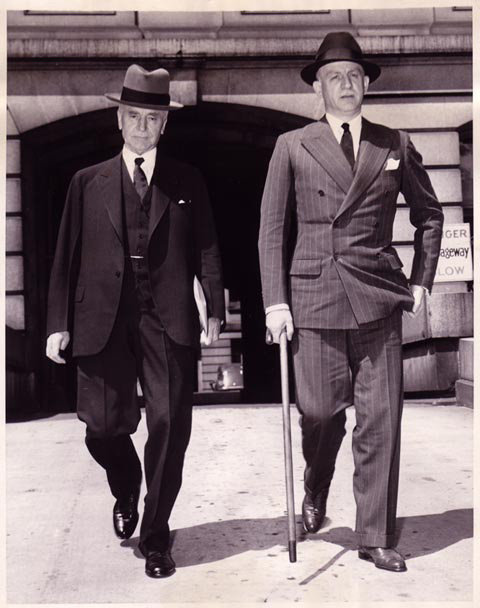
Secretary of State Cordell Hull and Sumner Welles
The SecofState was Cordell
Hull who authored the federal income tax laws of 1913 and 1916 and the
inheritance tax of 1916.
How can we get a UN? a New World Order?? We need ANOTHER WORLD WAR...
http://www.missionislam.com/nwo/illuminati.htm
"The planning of UN can be traced to the 'secret steering committee'
established by Secretary [of State Cordell] Hull in January 1943. All of the
members of this secret committee, with the exception of Hull, a Tennessee
politician, were members of the Council on Foreign Relations. They saw
Hull regularly to plan, select, and guide the labors of the [State] Department's
Advisory Committee. It was, in effect, the coordinating agency for all the State
Department's postwar planning."
Professors Laurence H. Shoup and William Minter, writing in their study of the
CFR, "Imperial Brain Trust: The CFR and United States Foreign Policy."
(Monthly Review Press, 1977).
http://www.conspiracyarchive.com/NWO/Council_Foreign_Relations.htm
...
The original concept for the UN was the outcome of the Informal Agenda Group,
formed in 1943 by Secretary of State Cordell Hull. All except Hull
were CFR members, and Isaiah Bowman, a founding member of the CFR, originated
the idea.
http://www.bibliotecapleyades.net/sociopolitica/global_tyranny/global_tyranny03.htm
...
In January 1943, Secretary of State Cordell Hull formed a steering committee
composed of himself, Leo Pasvolsky, Isaiah Bowman, Sumner Welles, Norman Davis,
and Morton Taylor. All of these men - with the exception of Hull - were in
the CFR.

Japanese Ambassador Admiral Kichisaburō Nomura (left) and Special Envoy
Saburō Kurusu (right) meet Hull for the last time on 17 November 1941,
two weeks before the attack on Pearl Harbor (7 December 1941).
http://www.presidency.ucsb.edu/ws/index.php?pid=16030&st=new+world+order&st1=#ixzz1NIjcQOCy
Address for Navy and Total Defense Day. October 27, 1941 : Franklin D.
Roosevelt: Address for Navy and Total Defense Day.
...
The other day the Secretary
of State of the United States was asked by a Senator to justify our giving aid
to Russia. His reply was: "The answer to that, Senator, depends on
how anxious a person is to stop and to destroy the march of Hitler in his
conquest of the world. If he
were anxious enough to defeat Hitler, he would not worry about who was helping
to defeat him."
So who was The SOS SecState? - Cordell Hull:
http://en.wikipedia.org/wiki/Cordell_Hull
Cordell Hull (October 2, 1871 – July 23, 1955) was an American politician from
the U.S. state of Tennessee. He is best-known as the longest-serving
Secretary of State, holding the position for 11 years (1933–1944) in the
administration of President Franklin Delano Roosevelt during much of World
War II.
Hull received the Nobel Peace
Prize in 1945 for his role in establishing the United Nations, and was referred
to by President Roosevelt as the "Father of the United Nations".
Why you should vote for Democrat's (or anybody for that matter)
Hull served 11 terms
in the United States House of Representatives (1907–1921 and 1923–1931) and
authored the federal income
tax laws of 1913 and 1916 and the inheritance tax of 1916.
After an electoral defeat in 1920, Hull served as chairman of the Democratic
National Committee.
...
In 1939, Hull advised
President Roosevelt to reject the SS St. Louis carrying 936 Jews seeking asylum.
Hull's decision sent these people back to Europe on the heels of the Nazi
Holocaust.
...
Hull became the underlying force and architect in the creation of the United
Nations, drafting, along with his staff, the United Nations Charter in
mid-1943. He resigned as Secretary of State in November 1944 because of failing
health.
Hull resigned as Secretary of State in November 1944 because of failing health.
Roosevelt described Hull, upon his departure as "the one person in all
the world who has done his most to make this great plan for peace (the United
Nations) an effective fact".
In 1945 Cordell Hull was awarded the Nobel Peace Prize for
"co-initiating the United Nations".
Hull died after suffering several strokes and heart attacks in 1955 in
Washington, D.C., and is buried in the vault of the Chapel of St. Joseph of
Arimathea in the Washington National Cathedral, which is an Episcopal
church.
http://www.barefootsworld.net/fs_m_ch_08.html
Secrets of the Federal Reserve - by Eustace Mullins
The Rothschilds were wary of Germany’s ability to continue in the war,
despite the financial chaos caused by their agents, the Warburgs, who were
financing the Kaiser, and Paul Warburg’s brother, Max, who, as head of the
German Secret Service, authorized Lenin’s train to pass through the lines and
execute the Bolshevik Revolution in Russia. According to Under Secretary of
the Navy, Franklin D. Roosevelt, America’s heavy industry had been
preparing for war for a year. Both the Army and Navy Departments had been
purchasing war supplies in large amounts since early in 1916.
Cordell Hull remarks in his Memoirs:
"The conflict forced the further development of the income-tax principle.
Aiming, as it did, at the one great untaxed source of revenue, the income-tax
law had been enacted in the nick of time to meet the demands of the war. And the
conflict also assisted the putting into effect of the Federal Reserve System,
likewise in the nick of time."70
One may ask, in the nick of time for whom? Certainly not for the American
people, who had no need for "mobilization of credit" for a
European war, or to enact an income tax to finance a war. Hull’s statement
affords a rare glimpse into the machinations of our "public servants".
...
See also: Origins
of RAND - Tuxedo Park - Alfred Lee Loomis
Mao
was a Yale Man - Yali and the Skull and Bones
quote author=TahoeBlue link=topic=154829.msg920461#msg920461 date=1263158247]
Quote
Yet Stilwell only reflected orders from Washington, from General George C.
Marshall. And as Admiral Cooke stated to Congress,
"... in 1946 General Marshall used the tactics of stoppage of ammunition to
invisibly disarm the Chinese forces. [3]
But when we get to General Marshall we need to remember that in the U.S. the
civilian branch has final authority in matters military and that gets us to then
Secretary of War Henry L. Stimson, Marshall's superior and a member of The
Order (1888).
By an amazing coincidence, Stimson was also Secretary of War in 1911 -- at
the time of the Sun Yat Sen revolution.
Henry L. Stimson - NYT OBIT:
http://www.nytimes.com/learning/general/onthisday/bday/0921.html
Henry L. Stimson Dies at 83 In His Home on Long Island
Special to THE NEW YORK TIMES
HUNTINGTON, L.I., Oct. 20-- October 21, 1950
Henry L. Stimson, former Secretary of War, died here at 4 P. M. today in his
home, Highhold, West Hills. He had celebrated his eighty-third birthday on Sept.
21.
...
As President Truman's senior adviser on military use of atomic energy, Henry
L. Stimson made the deciding recommendation to drop the first atomic bomb,
one of the most significant events in the history of mankind.
...
Attracted Elihu Root
It was Mr. Stimson's great good fortune as a young man of solid social
background and education at Yale and Harvard to attract the attention of Elihu
Root, then near the zenith of his long and influential career as a conservative
Republican statesman and lawyer.
...
Young Henry was sent to Phillips Andover Academy, where, he recalled in
later life, the students enjoyed "perfect freedom, tempered by
expulsion." [Andover Academy had a Pre-S&B society]
Mr. Stimson entered Yale in 1884 and spent the summer of his freshman year
roughing it in the wilds of Canada. He was elected near the end of his junior
year to Skull and Bones, oldest of the senior societies. He was graduated in
1888. After two years at Harvard Law School he was admitted to the bar in New
York in 1891. By the end of 1905, as a member of Senator Root's law firm, he was
making some $20,000 a year, and in January, 1906, President Theodore Roosevelt
appointed him United States Attorney for the Southern District of New York, his
first public post. The salary was half what he had been making in private
practice.
...
When a vacancy occurred in the post of Secretary of War, President Taft took
thought to the political needs of the Republican party in this state and
appointed Mr. Stimson, probably on the recommendation of Mr. Root who, as
Secretary of War in the Cabinets of McKinley and Roosevelt, had taken the
far-reaching step of forming the Army's first General Staff.
When Mr. Stimson took office on May 22, 1911, the United States Army
consisted of some 4,300 officers and 70,250 enlisted men, most of them
distributed among obsolete military posts. Major Gen. Leonard Wood was Chief of
Staff when Mr. Stimson became Secretary of War, and with Wood's aid the new
Secretary was able to effect a new and more-efficient regrouping of the nation's
tiny forces. But the nation was almost completely uninterested in army matters,
and Mr. Stimson's post was easily the most unimportant in the Cabinet.
The outbreak of the first World War in 1914 found the United States Army
almost completely unprepared, much to Mr. Stimson's regret. [ Really? you really
think so?]
...
Secretary of State in '31
Mr. Stimson was Secretary of State during the 1931 Manchurian crisis [always
there for a crisis], which with the Ethiopian crisis of 1936 and the Munich
appeasement of 1938, constituted the major retreats made by the Western powers
before the nationalistic aggression that led to the second World War. President
Hoover, who himself had considerable personal knowledge of Far Eastern affairs,
had great confidence in Mr. Stimson's judgment in this field and gave him
virtually a free hand. The Manchurian storm broke almost without warning.
On Sept. 17, 1931, Mr. Stimson received Katsuji Dubuchi, Japanese Ambassador,
and both agreed that tensions in the Far East seemed to be relieved and that
Japanese-American relations were much improved. Two days later Japanese troops
occupied the Manchurian arsenal city of Mukden and other points in south
Manchuria, territory claimed by China.
...
The beginning of the second World War in 1939 found the War Department split by
a feud between Secretary of War Harry H. Woodring and Assistant Secretary Louis
Johnson. In a typically Rooseveltian stroke of political daring, the
President decided to invite Mr. Stimson to accept the War post which the
harassed Secretary Woodring finally vacated. It was formally offered in a
telephone call from President Roosevelt on June 19, 1940. At the same time
another Republican, Frank Knox of Chicago, was invited to become Secretary of
the Navy, and accepted.
Mr. Stimson was 73 years old when he accepted the colossal task of carrying
forward his country's preparation for taking part in a war from which it was
almost certain that it could not keep free.[ Just in time AGAIN for Pearl
Harbor!!!] He was remembered for the failure of his Manchurian policy, and
his advanced years caused it to be said openly in Washington that he would
collapse under the strain.
With an energy that would have been astonishing in a man twenty years younger,
Secretary Stimson grappled with the task of making the ground and army air
forces ready for almost certain war service. When he had been Secretary of War
in 1911, there had been almost endless time to prepare for war, but no money.
Now there was almost inexhaustible money and no time.
United States Attacked by Japan
The Japanese attacked us on Dec. 7, 1941, and then and later, Mr.
Stimson became involved in the controversy over who was to blame for the fact
that the American land and sea forces were surprised at Pearl Harbor.
Secretary Stimson maintained that Lieut. Gen. Walter Short, commanding in
Hawaii, had been adequately warned before the attack. Another and very tenacious
school of thought held that the warning had not been sufficiently explicit.
...
In the fall of 1941 President Roosevelt named Secretary Stimson to a
committee to advise on nuclear fission policy [Before Pearl Harbor!] , and
from May 1, 1943, until he resigned as Secretary of War, Mr. Stimson was the
President's senior adviser on the military employment of atomic energy.
...
Secretary Stimson selected four targets, two of which were subjected to the
atomic bomb attack--Hiroshima on Aug. 6, 1945, and Nagasaki three days
later. Both attacks caused great loss of life among civilians as well as among
members of the Japanese armed forces and also vast property damage.
When the armies that he had helped to raise were victorious in Europe and Japan
in the greatest conflict of all time, Mr. Stimson resigned as Secretary of
War on Sept. 21, 1945 [Mission completed!] , and retired to Highhold, his
Long Island estate, which he had occupied since 1903.
http://www.atomicarchive.com/History/mp/p3s2.shtml
 Stimson
had the Bomb
Stimson
had the Bomb
Part III: The Manhattan Engineer District
... Bush, with the help and authority of Secretary of War Henry L. Stimson,
setup the Military Policy Committee, including one representative each from the
Army, the Navy, and the Office of Scientific Research and Development [/quote]
http://tech.dir.groups.yahoo.com/group/prepare4contact/message/38745
"Cordell Hull saw Aliens in Glass Containers"
William E. Jones writes, "I thought your readers should be aware of the
Cordell Hull story that alien artifacts were in our hands in 1939." In
early December of 1999 the Center of UFO Studies received a letter from the
daughter of the Reverend Turner Hamilton Holt: "Today I want to share some
knowledge that has been, by request, kept secret in our family since sometime in
World War II. This concerns something my father was shown by his cousin Cordell
Hull, the Secretary of State under Franklin Roosevelt. Snip, my father, who was
young, brilliant, and sound of mind, told us this story because he didn't want
the information to be lost.
One day when my father was in D.C,. Cordell swore him to secrecy and took him to
a sub-basement in the U.S. Capitol building, and showed him an amazing sight:
(1) Four large glass jars holding 4 creatures unknown to my father or Cordell
[and], (2) A wrecked round craft of some kind nearby.
"My father wanted my sister and I to make this information known long after
he and Cordell were dead, because he felt it was a very important bit of
information. We have researched your group {Mufon} and feel it is the most
reliable group in the country. We hope that you will research and search this
information. The jars with creatures in formaldehyde and the wrecked craft are
some where! "Cordell said they were afraid they would start a panic if the
public found out about it." Sincerely, Lucile Andrew, Ashland, Ohio.
"Cordell Hull was one of the greatest statesmen of the 20th Century
with absolutely no apparent reason to tell this story unless it was true,
especially at a time when stories of flying saucers and their Alien drivers had
not yet become part of our culture. Hull was elected U.S. Senator 1931-1937, as
chairman of the Democratic National Committee, and became the Secretary of State
under President Franklin D. Roosevelt in March 1933, the longest in American
history until 1944, when he resigned because of ill health. He was also offered
the Vice Presidency and in 1945, Cordell Hull won the 1945 Nobel Prize for
Peace.
Notice that the steering commitee for the formation of the UN were the same
men from the CFR War and Peace studies group...
AND include the President and Vice President of the CFR , the sister group of
- Chatham House - The Royal Institute of International Affairs. http://www.sweetliberty.org/issues/shadow/cfrintro.htm
Notice that WWI
with millions dead, formation
of the Federal Reserve (1913), Implementation
of the Income Tax (1916) was not enough for them,
With U.S.
rejection of the League of Nations (1919), The last piece of the puzzle was
incomplete. They make the
Balfour agreement (1917) and the
Royal Institute (1920) and the
CFR (1921) and begin making plans for the NEXT BIG WAR....
There would be a New World Order, Who would control it?
http://www.bibliotecapleyades.net/sociopolitica/global_tyranny/global_tyranny03.htm
...
In January 1943, Secretary of State Cordell Hull formed a steering committee
[for the formation of the United Nations] composed of himself,
Leo
Pasvolsky, Isaiah Bowman, Sumner Welles, Norman Davis, and Morton Taylor. All
of these men - with the exception of Hull - were in the CFR. ...
Isaiah
Bowman, a founding member of the CFR
http://en.wikipedia.org/wiki/Sumner_Welles
Benjamin Sumner Welles (October 14, 1892 - September 24, 1961) was an
American government official and diplomat in the Foreign Service. He was a major
foreign policy adviser to President Franklin D. Roosevelt and served as Under
Secretary of State from 1937 to 1943, during FDR's presidency
...
In the week following Kristallnacht, in November 1938, the British
government stated that it would be willing to give up the major part of the
quota of 65,000 British citizens that could emigrate to the United States and
have Jews fleeing Hitler receive this instead. To this Under-Secretary Welles
responded:[24]
I reminded the Ambassador that the President stated there was no intention on
the part of his government to increase the quota for German nationals. I
added that it was my strong impression that the responsible leaders among
American Jews would be the first to urge that no change in the present quota for
German Jews be made...The influential Sam Rosenman, one of the
"responsible" Jewish leaders sent Roosevelt a memorandum telling him
that an 'increase of quotas is wholly inadvisable. It will merely produce a
'Jewish problem' in the countries increasing the quota.'
...
Historians credit Welles with
the for design of the United Nations.
FDR made Welles the key person and Welles had "a dominance over UN
planning" that was "starting to embitter Hull
[ Keep in mind that one of the first actions of the Newly formed United
Nations was the creation of Israel... ]
...
In 1944, Welles lent his name to a fund-raising campaign by the United Jewish
Appeal to bring Jewish refugees from the Balkans to Palestine
...
In 1945, he joined the American Broadcasting Company to guide the
organization of the "Sumner Welles Peace Forum," a series of 4
radio broadcasts providing expert commentary on the San Francisco Conference,
which wrote the founding document of the United Nations
...
In 1948, Welles authored We Need Not Fail, a short book that first
presented a history and evaluated the competing claims to Palestine. He
argued that American policy should insist on the fulfillment of the 1947 promise
of the United Nations General Assembly to establish two independent states
within an economic union, policed by a United Nations force
...
Later that year, the American Jewish Congress presented Welles with a
citation that praised his "courageous championing of the cause of Israel among
the nations of the world."[51]
Welles was a member of the American branch of the Institute of Pacific
Relations, an organization that fostered the study of the Far East and the
Pacific. Senator Joseph McCarthy repeatedly charged that it was a
[Rockefeller] Communist front.
The
IPR was investigated by the Senate in 1951 -
The Sorge Spy Ring
Mr. Morris. General, approximately how many members were there in that ring ?
General Willoughby. Fifteen to twenty. While the personnel of this ring
varied from time to time, this skillful bank of spies — agents, if you
wish — worked for nine productive years before their discovery. The famous
Canadian spy case was one of the best examples of this type of espionage. I
believe, however, that the Sorge efforts in Tokyo compare most favorably with
this famous case.
Senator Ferguson. How many nationalities were in this ring?
Sorge was a German ?
General Willoughby. Yes.
Senator Ferguson. Guenther Stein was British?
General Willoughby. British citizen of German origin.
Senator Ferguson. Smedley was an American ?
General Willoughby. Was an American.
 Agnes Smedley(far
right) with her friends Mao Tsetung(left) and general Chu Teh in Yenan guerilla
base. 1937
Agnes Smedley(far
right) with her friends Mao Tsetung(left) and general Chu Teh in Yenan guerilla
base. 1937
OSS
recruits IPR members : Internationalizing the Pacific: the United States, Japan,
and the IPR ... By Tomoko Akami
http://conservapedia.com/Alger_Hiss
Alger Hiss
Alger Hiss (November 11, 1904 – November 15, 1996) was a high-ranking[1]
U.S. State Department official and Secretary-General[2] of the founding
conference of the United Nations. Hiss was convicted of perjury in 1950,
after denying involvement in Soviet espionage. For decades, a great number of
Americans saw Hiss, a liberal[3] Democrat,[4] as an innocent victim of
McCarthyism.[5]
"Hiss was indeed a Soviet agent and appears to have been regarded by
Moscow as its most important," wrote Senator Daniel Patrick Moynihan
(D.-N.Y.), who was instrumental in the declassification of Venona decrypts and
FBI files on the case,[6] which had been classified for half a century.
"Parts of the American government had conclusive evidence of his
guilt," concluded the liberal Democrat[7] in 1998, "but they never
told."[8] ...
...
Hiss became president of the Carnegie Endowment for International Peace,
serving also as a trustee of the closely-related[330] Institute of Pacific
Relations,[331] which would later be identified by the Senate Judiciary
Committee as "a vehicle used by the Communists to orientate American far
eastern policies toward Communist objectives."[332]
http://en.wikipedia.org/wiki/Kristallnacht
Kristallnacht, also to referred to as the Night of Broken Glass, and also
Reichskristallnacht, Pogromnacht, and Novemberpogrome, was a pogrom or series
of attacks against Jews throughout Nazi Germany and parts of Austria on November
9–10, 1938.
...
Ninety-one Jews were killed, and 30,000 Jewish men—a quarter of all Jewish
men in Germany—were taken to concentration camps, where they were tortured for
months, with over 1,000 of them dying.[2] Around 1,668 synagogues were
ransacked, and 267 set on fire. In Vienna alone 95 synagogues or houses of
prayer were destroyed
http://en.wikipedia.org/wiki/War_and_Peace_Studies
War and Peace Studies was a project carried out by the Council on Foreign
Relations between 1939 and 1945 before and during American involvement in World
War II. It was intended to advise the U.S. Government on conduct in the war
and the subsequent peace.
The project was divided into four major areas: economic and financial, security
and armaments, territorial, and political. Over 100 men took part. Funding
was provided by the Rockefeller Foundation, which provided almost $350,000 over
the course of the project. A steering committee was created in December 1939
chaired by U.S diplomat Norman Davis with Foreign Affairs editor Hamilton Fish
Armstrong as vice-chairman. Initial area heads were:[1]
Alvin Hansen and Jacob Viner led the economic and financial group
Whitney Shepardson, who led the political group
Allen Welsh Dulles and Hanson W. Baldwin, who led the armaments group,
and
Isaiah Bowman, who led the territorial group.
A research secretary was appointed to each group:
William Diebold, for the economic and financial group
Walter R. Sharp, for the political group, and
Grayson L. Kirk, for the armaments group
William P. Maddox, for the territorial group
From March 1942, the project supplied research secretaries to the State
Department's Advisory Committee on Postwar Foreign Policy, with each group's
secretary serving the corresponding subcommittee at the State Department.
Meetings were scheduled to allow secretaries to carry out Council work during
the first half of each week with the remainder of the week spent at the
Department of State.[2]
http://en.wikipedia.org/wiki/Norman_Davis
Norman H. Davis (1878–1944), was a U.S. diplomat. He was born in
Bedford, Tennessee. He served as President Wilson's Assistant Secretary of
Treasury and later as Undersecretary of State.
Davis headed commission of the League of Nations that negotiated the Klaipėda
Convention in 1924. He was a delegate to a General Disarmament Conference in
Geneva in 1931. He was chairman of the International Federation of Red Cross and
Red Crescent Societies from 1938 to 1944 and president
of the Council on Foreign Relations 1936–1944.
In 1939, following the
outbreak of war in Europe, Davis chaired the steering committee of the Council
on Foreign Relations' War and Peace Studies project, created to
advise the U.S. Government on wartime policy. He would also join the State
Department's committee on overseas war measures, the fifteen-member Advisory
Committee on Problems of Foreign Relations.
http://en.wikipedia.org/wiki/Isaiah_Bowman
Isaiah Bowman, AB, Ph. D. (26 December 1878, Waterloo, Ontario, Canada
– 6 January 1950, Baltimore, United States) was an American geographer. He was
educated at Harvard and Yale where he taught from 1905 to 1915, after which time
he became the director of the American Geographical Society, a position he held
for 20 years from 1915 to 1935
...
served the Department of State as territorial adviser during World War II
...
Before and during World War II he served on the Council of Foreign Relation's
War and Peace Studies as chairman of its territorial group.[1] From 1945 to
1949 he was a CFR
vice-president
We really don't know what this guy did (to deserve all the awards):
http://en.wikipedia.org/wiki/Hamilton_Fish_Armstrong
Hamilton Fish Armstrong (April 7, 1893 – April 24, 1973) was a United States
diplomat and editor
...
After 1922, he worked at Foreign Affairs, the review of Council on Foreign
Relations, as adjoint of Archibald Cary Coolidge. After his death in
1928, he became the editor of the magazine. Armstrong retired from Foreign
Affairs in 1972,
Hamilton Fish Armstrong was awarded by Serbia, Romania, Czechoslovakia,
France and United Kingdom:
Order of the Serbian Red Cross (1918)
Order of St. Sava Fifth Class (1918)
Chevalier of Order of the White Eagle with Swords (1919)
Order of the Crown (Rumania) in 1924
Order of the White Lion of Czechoslovakia in 1937
Officer of the Legion of Honor of France (1937) and became a commander in 1947
Commander of the British Empire in 1972
He received honorary degrees from Brown (1942), Yale (1957), the
University of Basel (1960), Princeton (1961), Columbia (1963), and Harvard
(1963).
http://en.wikipedia.org/wiki/Foreign_Affairs
Foreign Affairs is an American magazine and website on international
relations and U.S. foreign policy published since 1922 by the Council on Foreign
Relations (CFR) six times annually. The CFR is a private-sector group
established in New York City in 1921, with the mission of promoting
understanding of foreign policy and America’s role in the world.
The Council on Foreign Relations was originally composed of 75 members of
mainly academic and professional backgrounds. In its first year, the Council
sought discourse mainly in meetings at its headquarters in New York City.
However, the members of the Council wished to seek a wider audience, and, as
a result, began publishing Foreign Affairs in 1922
http://www.conservapedia.com/Owen_Lattimore
Owen Lattimore was U.S. political advisor to Chiang Kai-shek in 1941; after
Pearl Harbor he became director of Pacific Operations for the United States
Office of War Information.[1] According a unanimous report of the Senate
Judiciary Committee, he was also "from some time beginning in the 1930's, a
conscious articulate instrument of the Soviet conspiracy."[
...
During the Nazi-Soviet pact, Lattimore was added to Roosevelt's Custodial
Detention Index,[14] listed as "Nationalistic tendency—Communist."[15]
Later the same year President Franklin Roosevelt appointed Lattimore U.S.
adviser to Kuomintang Generalissimo Chiang Kai-shek on the surreptitious and
out-of-process recommendation of Lattimore's personal friend and patron at the
White House,[16] Roosevelt adviser and NKVD agent Lauchlin Currie.[17] While
serving in this capacity, according to Chinese military intelligence, Lattimore
was sending coded messages to the Communist Chinese rebels.[18]
On November 25, 1941, twelve days before Pearl Harbor, Lattimore dispatched
an anxious cable to Currie in the White House arguing against a proposed
diplomatic understanding between the United States and Japan. When Congress
later investigated the Pearl Harbor attack, U.S. Secretary of State Cordell
Hull testified that he took a tough line with the Japanese because of this cable
from Lattimore to Currie reporting on Chinese morale in the Kuomintang. This
cable was the only documentary evidence Hull presented which influenced his
decision to reverse himself and send the ultimatum to Japan.
Related to this is Lauchlin Currie Assistant to FDR and Soviet Spy who
recommended Lattimore for his job....
http://www.conservapedia.com/Lauchlin_Currie
Lauchlin Bernard Currie (8 October 1902 - 23 December 1993) was Administrative
Assistant to President Franklin Delano Roosevelt, and a Soviet spy.
...
Currie became Administrative Assistant to President Franklin Roosevelt in
July of 1939[1], and was empowered to coordinate "the work of the
various departments in their relations to the Executive." [2]
Whittaker Chambers, a former affiliate of the Soviet Secret Intelligence
Service in Washington, D. C., for the purpose of developing a government
underground, stated that Lauchlin Currie was a 'fellow Traveler' who helped
various Communists. This statement was made to a representative of the State
Department when Chambers was questioned relative to individuals in the
Government who were allegedly active in behalf of the Communist Party and the
Soviet Union.
...
Soviet archives likewise identify Currie as a Soviet intelligence source.
In 1948, Anatoly Gorsky identified Currie in the "Gorsky memo"as the
Soviet agent code-named "PAZh/Page,"[10] who is recorded in Venona
giving information to Akhmerov and "handing over documents" to
Silvermaster.
...
In the early part of 1941, Currie was sent to be Head of the Economic Mission
to China as personal envoy of the President to confer with Chiang Kai-shek and
other leading executives of the Kuomintang. Currie studied Chinese arsenals,
military training schools, and industrial cooperatives while in China.
...
Amerasia scandal
Currie was listed as one of the individuals who attended the Institute of
Pacific Relations Conference held at Mont Tremblant, Canada, from December 5 to
19, 1942. In the early part of September 1943, Currie was appointed as Acting
Deputy Administrator and he remained until the early part of 1945. He then
resumed his former White House duties.
It was Currie who recommended Owen Lattimore to President Roosevelt to serve
as a special advisor to Jiang Jieshi(Chiang Kai-shek). [18]
http://www.documentstalk.com/wp/currie-lauchlin-bernard-1902-1993

Currie with Madame Chiang Kai Shek
Currie was a top-level adviser in President Franklin D. Roosevelt’s New Deal
and served as FDR’s economic adviser in the White House from 1939-1945. From
1949 until his death in 1993, he was a top-level development economist in Latin
America.
...
In 1944-1945, he took part in loan negotiations with the United States’
British and Soviet allies, as well as in preparations for the United Nations
Monetary and Financial Conference at Bretton Woods, New Hampshire (July 1-22,
1944), which led to the creation of the World Bank and the International
Monetary Fund.
...
Currie was hired by the World Bank in 1949 despite earlier allegations of
Soviet espionage made by two defectors from the Communist cause –
Elizabeth Bentley and Whittaker Chambers. Bentley claimed that Currie, whom she
had never seen, had been part of an espionage ring headed by Nathan Gregory
Silvermaster.
Spies and more spies...
[ Currie - The Rothschild/Soviet Spy ] In the early part of 1941,
Currie was sent to be Head of the Economic Mission to China as personal envoy
of the President to confer with Chiang Kai-shek and other leading executives
of the Kuomintang. Currie studied Chinese arsenals, military training
schools, and industrial cooperatives while in China.
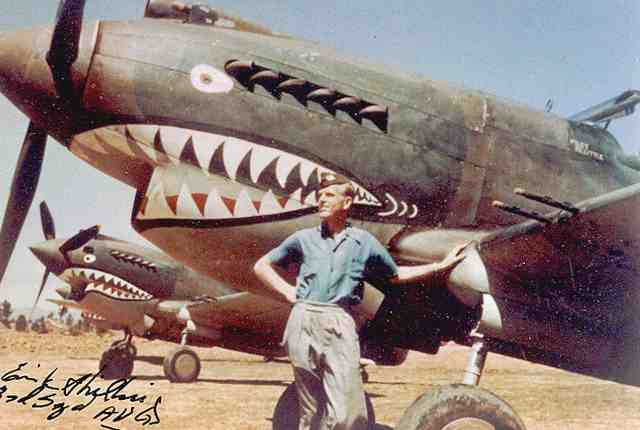
http://flyingtigersus.wordpress.com/
Like Lauchlin Currie at the White House, Bill Pawley was central to the
creation and management of the American Volunteer Group, but was so hated by
Chennault that he never got full credit for his role. This is a first cut at a
Pawley biography, with emphasis on its intersection with the Flying Tigers
story.

CAMCO personnel at Loiwing, China, probably at the factory opening in 1939.
Bill Pawley is standing in back, second from left. Ed Pawley is third from
right, and Gene Pawley may be the man in the center of the photo; all three are
wearing white shirt and tie. (Hat tip: Eugenie Buchan)
http://en.wikipedia.org/wiki/William_D._Pawley
...
1932 - He then became president of Intercontinent Corporation in New York,
evidently founded by Clement Keys, the former president of Curtiss.
In 1933 he moved to China where he became president of China National
Aviation Corporation an airline running between Hong Kong and Shanghai. Pawley
finally sold out to Pan Am again.
He later assembled aircraft in partnership with the Chinese Nationalist
government under the corporate name of Central Aircraft Manufacturing Company in
Hangzhou, Wuhan, and finally Loiwing on the China-Burma border. (CAMCO was
owned in partnership with the Chinese government, with the Pawley family
interest represented by Intercontinent, which now served as a Pawley family
holding company.)
In 1941, with his brothers Edward and Eugene, he was involved with the
organization and support of the 1st American Volunteer Group, popularly known as
the Flying Tigers. The brothers established an assembly plant at Mingaladon
airport outside Rangoon, Burma, where the AVG's Curtiss P-40 fighter aircraft
were assembled, while an Intercontinent office in Rangoon (now Yangon) provided
payroll and other housekeeping services to the group while it trained upcountry
at Toungoo. Later, when Allied forces were driven out of lower Burma by the
Japanese, the CAMCO factory and airfield across the border in Loiwing, China,
served as a base for the AVG. When Loiwing in turn was captured by Japan in May
1942, Pawley moved his operation to India as a partner in Hindustan Aircraft
Limited.
Pawley was appointed as U.S. Ambassador by Harry Truman to Peru in 1945. He was
named U.S. Ambassador to Brazil in 1948.
Postwar, Pawley was an active member of the Republican Party. A close friend
of both President Dwight Eisenhower and Central Intelligence Agency
director Allen W. Dulles, he took part in a policy that later become
known as Executive Action,
a plan to remove unfriendly foreign leaders from power.
Pawley played a role Operation PBSUCCESS, a CIA plot to overthrow the
Guatemalan government of Jacobo Arbenz in 1954 after Arbenz introduced land
reforms and nationalized the United Fruit Company.
Pawley is thought to have served [the CIA] in Peru, Brazil, Panama,
Guatemala, Cuba and Nicaragua between 1945 and 1960.
His final residence was in Miami Beach, Florida, where he died of a
self-inflicted gunshot wound, in January 1977, because he suffered from a
severe case of the very painful disease - shingles.
United States Ambassador to Peru - 20 July 1945–27 April 1946
United States Ambassador to Brazil - 13 June 1946–26 March 1948
http://williampawley.blogspot.com/
MORE RUTHLESS THAN THE ENEMY: The Dark Diplomacy of Ambassador William
Douglas Pawley
David Price Cannon began researching the life of Ambassador William Douglas
Pawley over 35 years ago. An aviation pioneer in Cuba and China. Founder of the
Flying Tigers. Global entrepreneur. Diplomat in Peru and Brazil.
Advisor to President's Franklin D. Roosevelt, Harry S. Truman, Dwight D.
Eisenhower and Richard Nixon.
An architect of U.S. covert policy. Coup plotter against governments in
Guatemala and Cuba. A CIA covert agent. An organizer of Cuban exiles for the Bay
of Pigs Invasion. A critic of President John Fitzgerald Kennedy. A friend
of Clare Boothe Luce, CIA Director Allen Dulles, FBI Director J. Edgar Hoover,
Senator James Eastland and foreign dictators.
A name high on the witness list for the U.S. House Select Committee on
Assassination's hearings at the time Pawley committed suicide.
Although an Ambassador and a friend of Secretary of State George C. Marshall,
William D. Pawley despised those in the State Department who believed diplomacy
was superior to sabotage and subversion in Russia, Guatemala, Cuba and China. He
fed his own paranoia and became its most vocal advocate.
...
Researching Pawley's life took decades because hundreds of documents relating
to his covert activities during the 1950s and 60s were classified for three
decades. They were finally made available through the combined efforts of
the Mary Ferrell Foundation -- http://www.maryferrell.org/
-- which provides online access to more than one million pages of declassified
documents.
The majority of them come from the Assassination Archives and Research Center
in Washington DC, run by James Lesar: http://www.aarclibrary.org/
Many additional details about William Douglas Pawley were found in the Pawley
Collection at George C. Marshall Library in Lexington, Virginia: http://www.marshallfoundation.org/
...
William Pawley expedites the creation of China National Aviation Corp. He
then forms Central Aircraft Manufacturing Company, headquartered at 30
Rockefeller Plaza in New York City, to recruit Claire Chennault and other
pilots for The Flying Tigers (American Volunteer Group) which defends
Generalissimo Chiang Kai-shek’s forces against the invading Japanese.
This brings Pawley into contact with President Franklin D. Roosevelt and
Madame Chiang’s brother, T.V. Soong, who finances the Flying Tigers and then
emerges from World War II as one of the wealthiest men in the world and a leader
of the China Lobby.
Pawley shifts aircraft manufacturing to the safety of India to support the
American pilots. He gains major press coverage from newspapers and Time
magazine, which leads to his friendship with Henry and Clare Boothe Luce, a
woman with similar political opinions and interests. Pawley later states
that during this period “I first began to feel a growing alarm at the threat
of world communism.”
http://www.jfk-assassination.de/articles/deaths.php
The HSCA Investigation
Just when the House Select Committee on Assassinations was investigating the JFK
assassination, more suspicious deaths were coming up:
Date Name Connection with case Cause of Death
1/77 William Pawley* Former Brazilian Ambassador connected to Anti-Castro
Cubans, crime figures Gunshot ruled suicide
3/77 George DeMohrenschildt* Close friend to both Oswald and Bouvier family
(Jackie Kennedy's parents), CIA contract agent Gunshot wound ruled suicide
3/77 Carlos Prio Soccaras* Former Cuban President, money man for anti-Castro
Cubans Gunshot wound ruled suicide
3/77 Paul Raigorodsky Business friend of George DeMohrenschildt and wealthy
oilmen Natural causes
5/77 Lou Staples* Dallas radio Talk Show host who told friends he would break
assassination case Gunshot to head,ruled suicide
6/77 Louis Nichols Former No. 3 man in FBI, worked on JFK investigation Heart
attack
8/77 Alan Belmont FBI official who testified to Warren Commission "Long
illness"
8/77 James Cadigan FBI document expert who testified to Warren Commission Fall
in home
8/77 Joseph C. Ayres* Chief steward on JFK's Air Force One Shooting accident
8/77 Francis G. Powers* U-2 pilot downed over Russia in 1960 Helicopter crash
(He reportedly ran out of fuel)
http://educationforum.ipbhost.com/index.php?showtopic=5068&st=75
...
Pawley was brought in by Tommy Corcoran to head CAMCO, the engineering
company that would assemble the crated airplanes to be flown by the AVG pilots.
Since the OSS did not exist at that time, all this was done under the aegis of
the intelligence service of the Department of State, supported by the Office of
Naval Intelligence which was active on the China coast, and Secretary of War
Stimson (who had previously been governor-general of the Philippines and was a
friend of Corcoran, Luce, Pawley, United Fruit and Dole Pineapple, and an
admirer of Mme. Chiang).
Eventually the AVG got its act together and evolved into the Flying Tigers. When
the US declared war on Japan, Chennault was reinstated to the Army Air Corps
responsible to General Stilwell. All but a handful of the Flying Tigers refused
to re-join the Air Corps and mutinied. The mutiny was kept secret until the late
1970s.
They were disbanded, many returning to America to get on with their lives,
others drifting into Chennault’s airlift over the Hump from India to China,
during which gold, drugs and diamonds were carried aboard some of the planes.
Among those who were eyewitnesses was John D. McDonald, who later became famous
as a novelist.
There was a mob of British and American spooks in Chungking and Kunming,
where Alsop (given a commission in the US Army) served as Chennault’s
mouth-piece to hype the image of the Flying Tigers. The famous name was adopted
for all Chennault’s fighter pilots, and was implicit in his choosing the name China
Air Transport (CAT) for the OSS subsidized cargo airline Chennault used to
smuggle heroin out and weapons into KMT controlled areas. After the Chiangs fled
to Taiwan, CAT became Air America.
Who was "Tommy the Cork Corcoran" the original lobbyist and
influence peddler ? and notice how he shows up for JFK/LBJ:
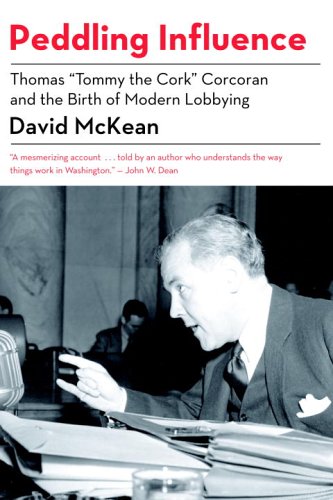
http://www.brownalumnimagazine.com/content/view/1773/40/
...
Tommy the Cork's influence continued for decades. He helped cement the
connection between a young Lyndon Johnson and the puissant House Speaker Sam
Rayburn, both Texas Democrats. And according to Mutual Contempt, the book on
Johnson and Bobby Kennedy written by Jeff Shesol '91, The Cork was among
those who fixed the unlikely JFK-Johnson ticket in 1960. At the Democratic
Convention in Los Angeles that July, Corcoran caught Kennedy alone in an
elevator. With the elevator door slamming repeatedly on his foot, The Cork asked
the future president for permission to sound out then-Senate majority leader
Johnson over the vice presidency.
Kennedy gave him the green light. "Tommy," he said, "you have
peculiar abilities." This was just the sort of compliment Corcoran
relished. "He liked people to think that he could do the impossible,"
says Tom Corcoran Jr. "Power - that's what he liked the best."
http://www.smokershistory.com/Corcoran.htm
...
1954 United Fruit Co. coup in Guatemala
"The US, headed by John Peurifoy, the new US Ambassador to Guatemala, and
Frank Wisner, the CIA's operations chief on Guatemala, implemented an elaborate
plan entitled 'Operation Success' (a name quite indicative of the US
feelings toward the mission) that included pirating a radio show that blocked
the airways called the 'Voice of Liberation,' Armas attack on villages and
trains, US pilots bombing Guatemala City, and Peurifoy demanding Arbenz
resignation. All the while, the US claimed to have no intervention in Guatemalan
affairs....
Thomas Corcoran (head of UFCO's Washington lobbyists) was old friends with
Franklin Roosevelt and William Bedell Smith. Sought an executive job with UFCO
while helping plan the coup (he was later named to its board of directors."
(US Backed Coup d'Etat in '54 Leads to Military Regime in Guatemala: Thousands
Killed, by Al Ferkel. Chart, Connections between UFCo and US Gov't during the US
backed coup d'etat. Moravian University forum. Link dead.)
http://www.spartacus.schoolnet.co.uk/JFKcorcoran.htm
...
Corcoran also became involved in advising Franklin D. Roosevelt over foreign
policy. Although he had liberal views on domestic issues, Corcoran was
passionately anti-communist. This was partly because of his Roman Catholicism.
Roosevelt initially favoured giving help to the Republican government in Spain.
However, Corcoran was a supporter of the fascist movement led by General
Francisco Franco.
...
Corcoran knew that Adolf Hitler and Benito Mussolini would continue to
provide both men and arms to Francisco Franco. Roosevelt's decision enabled
fascism to win in Spain and become entrenched in Europe. Roosevelt later told
his cabinet that he had made a "grave mistake" with respect to
neutrality in the Spanish Civil War.
Roosevelt was angry with Tommy Corcoran over his advice on Spain. He also
began to see that Corcoran was becoming a problem for the administration. He had
upset a lot of powerful figures in Congress with his arm twisting tactics.
Corcoran had also tried to unseat those who attempted to resist Franklin D.
Roosevelt. For example, Walter George of Georgia claimed that Corcoran had the
"power of saying who shall be a senator and who shall not be a
senator."
...
Roosevelt believed that the best way of stopping Japanese imperialism in Asia
was to arm the Chinese government of Chiang Kai-shek. However, Congress was
opposed to this idea as it was feared that this help might trigger a war with
Japan. Therefore, Roosevelt's plan was for Corcoran to establish a
private corporation to provide assistance to the nationalist government in
China. Roosevelt even supplied the name of the proposed company, China Defense
Supplies. He also suggested that his uncle, Frederick Delano, should be
co-chairman of the company. Chiang nominated his former finance minister,
Tse-ven Soong, as the other co-chairman.
For reasons of secrecy, Corcoran took no title other than outside counsel for
China Defense Supplies. William S. Youngman was his frontman in China.
Corcoran's friend, Whitey Willauer, was moved to the Foreign Economic
Administration, where he supervised the sending of supplies to China. In this
way Corcoran was able to create an Asian Lend-Lease program.
Corcoran also worked closely with Claire Lee Chennault, who had been working
as a military adviser to Chiang Kai-shek since 1937. Chennault told Corcoran
that if he was given the resources, he could maintain an air force within China
that could carry out raids against the Japanese. Corcoran returned to the
United States and managed to persuade Franklin D. Roosevelt to approve the
creation of the American Volunteer Group.
Postwar, Pawley was an active member of the Republican Party. A close friend
of both President Dwight Eisenhower and Central Intelligence Agency director
Allen W. Dulles, he took part in a policy that later become known as
Executive Action, a plan to remove unfriendly foreign leaders from power.
Pawley played a role Operation PBSUCCESS, a CIA plot to overthrow the
Guatemalan government of Jacobo Arbenz in 1954 after Arbenz introduced land
reforms and nationalized the United Fruit Company.
Pawley is thought to have served [the CIA] in Peru, Brazil, Panama,
Guatemala, Cuba and Nicaragua between 1945 and 1960.
And More spooks:
This
started in Guatemala in 1954 but then spread to other countries in Latin
America. Operation 40 was used to assassinate people who got in their way.
Operaton
40 - ... Fabian Escalante names William Pawley as being one of those
who was lobbying for the CIA to assassinate Fidel Castro. (9) Escalante
points out that Pawley had played a similar role in the CIA overthrow of
Jacobo Arbenz Guzmán in Guatemala.
Interestingly, the CIA assembled virtually the same team that was involved
in the removal of Arbenz: Tracey Barnes, Richard Bissell, David Morales, David
Atlee Phillips, E. Howard Hunt, Rip Robertson and Henry Hecksher. Added to
this list was several agents who had been involved in undercover operations in
Germany: Ted Shackley, Tom Clines and William Harvey.
 http://www.washingtonpost.com/wp-dyn/content/article/2011/01/26/AR2011012606742.html
Nestor D. Sanchez, 83; CIA official led Latin American division
http://www.washingtonpost.com/wp-dyn/content/article/2011/01/26/AR2011012606742.html
Nestor D. Sanchez, 83; CIA official led Latin American division
By T. Rees Shapiro
Washington Post Staff Writer
Wednesday, January 26, 2011; 11:27 PM
Nestor D. Sanchez, 83, a retired CIA officer and Defense Department official
whose early intelligence career involved clandestine operations in Latin
America, died of congestive heart failure Jan. 18 at his home in Buckeystown,
Md.
Mr. Sanchez retired from the CIA in 1981 after three decades of service.
Most
of his time at the agency involved top-secret covert actions, including bloody
1954 coups in Guatemala and a 1960s plot to assassinate Cuban leader Fidel
Castro. Mr. Sanchez was also closely connected to former Panamanian dictator
Manuel Noriega, a onetime CIA paid informant.
In his later career, Mr. Sanchez was a deputy assistant secretary of defense
for Latin American affairs during the Reagan administration. He specialized in
providing Central American countries with U.S. military aid and funding.
At the time of his retirement, Mr. Sanchez was said by federal investigators
to have been linked to illegal U.S. arms deals to the so-called
"contras," anti-Sandinista rebels who were fighting the left-wing
government in Nicaragua.
In the ensuing scandal, which came to be known as the Iran-Contra affair, Mr.
Sanchez said that he was aware of the arms shipments but that he didn't know
their origin. He was never accused of wrongdoing.
Mr. Sanchez joined the CIA in 1952. His first assignment for the agency was as
a field intelligence officer during the Korean War, where he recruited
defectors to infiltrate North Korea.
...
A New Mexico native and fluent Spanish speaker,
Mr. Sanchez was sent to
Central America to help engineer the 1954 coup against the left-leaning
Guatemalan government of Jacobo Arbenz Guzman
Beginning in the early 1960s, Mr. Sanchez sharpened his focus on CIA
operations in Cuba.
...
on Nov. 22, 1963, Mr. Sanchez gave Cubela a hypodermic syringe filled
with poison and camouflaged as a writing pen. But the assassination attempt
never took place, and CIA officials later suspected that Cubela was a double
agent.
Mr. Sanchez later worked in Venezuela, Guatemala, Colombia and Spain before
retiring from the CIA as chief of the Latin American division.
...
He was 1950 graduate of the New Mexico Military Institute and
later
received a master's degree in geopolitics from Georgetown University [US Spook
U ]

Back to 1940 and the BSC:
 Sir William Samuel Stephenson
Sir William Samuel Stephenson
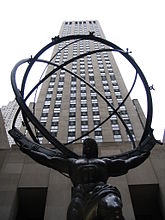 BSC was housed on the 35th and 36th floors of the International Building,
Rockefeller Center, New York
http://en.wikipedia.org/wiki/William_Stephenson
Sir William Samuel Stephenson, CC, MC, DFC (January 23, 1897 – January
31, 1989) was a Canadian soldier, airman, businessman, inventor, spymaster,
and the senior representative of British intelligence for the entire western
hemisphere during World War II.
BSC was housed on the 35th and 36th floors of the International Building,
Rockefeller Center, New York
http://en.wikipedia.org/wiki/William_Stephenson
Sir William Samuel Stephenson, CC, MC, DFC (January 23, 1897 – January
31, 1989) was a Canadian soldier, airman, businessman, inventor, spymaster,
and the senior representative of British intelligence for the entire western
hemisphere during World War II.
He is best-known by his wartime intelligence codename Intrepid.
Many people
consider him to be one of the real-life inspirations for James Bond.[2]
Ian
Fleming himself once wrote, "James Bond is a highly romanticized version
of a true spy. The real thing is ... William Stephenson." [3
...
After World War II began (and over the objections of Sir Stewart Menzies,
wartime head of British intelligence) now-
Prime Minister Winston Churchill
sent Stephenson to the United States on June 21, 1940, to covertly establish
and run British Security Coordination (BSC) in New York City, over a year
before U.S. entry into the war.
BSC, with headquarters at Room 3603 Rockefeller Center, became an umbrella
organization that by war's end represented the British intelligence agencies
MI5, MI6 (the Secret Intelligence Service, or SIS), SOE (Special Operations
Executive) and PWE (Political Warfare Executive) throughout North America,
South America and the Caribbean.[citation needed]
Stephenson's initial directives for BSC were to 1) investigate enemy
activities; 2) institute security measures against sabotage to British
property; and 3) organize American public opinion in favor of aid to Britain.
Later this was expanded to include "the assurance of American
participation in secret activities throughout the world in the closest
possible collaboration with the British". Stephenson's official title was
British Passport Control Officer.
His unofficial mission was to create a
secret British intelligence network throughout the western hemisphere, and to
operate covertly and broadly on behalf of the British government and the
Allies in aid of winning the war.
He also became
Churchill's personal representative to U.S. President Franklin D. Roosevelt.[citation
needed]
Stephenson was soon a close adviser to Roosevelt, and suggested that
he
put Stephenson's good friend William J. "Wild Bill" Donovan in
charge of all U.S. intelligence services.
Donovan founded the U.S. Office of Strategic Services (OSS), which in 1947
would become the Central Intelligence Agency (CIA).
As senior representative of British intelligence in the western hemisphere,
Stephenson
was one of the few persons in the hemisphere who were authorized to view raw
Ultra transcripts of German Enigma ciphers that had been decrypted at
Britain's Bletchley Park facility.
He was trusted by Churchill to
decide what Ultra information to pass along to various branches of the U.S.
and Canadian governments.[citation needed]
Under Stephenson, BSC directly influenced U.S. media (including newspaper
columns by Walter Winchell and Drew Pearson), and media in other hemisphere
countries, toward pro-British and anti-Axis views.
Once the U.S. had entered the war, in 1941–44 BSC went on to train U.S.
propagandists from the United States Office of War Information in Canada.
BSC covert intelligence and propaganda efforts directly affected wartime
developments in Brazil, Argentina, Colombia, Chile, Venezuela, Peru, Bolivia,
Paraguay, Mexico, the Central American countries, Bermuda, Cuba and Puerto
Rico.
http://bookish-hamster.blogspot.com/2009/11/man-called-intrepid.html
A Man Called Intrepid: The Incredible WWII Narrative of the Hero Whose Spy
Network and Secret Diplomacy Changed the Course of History
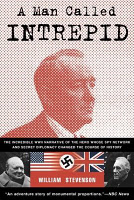
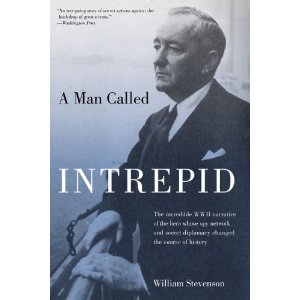 http://www.amazon.com/Man-Called-Intrepid-Incredible-Narrative/dp/159921170X/ref=sr_1_fkmr2_3?ie=UTF8&qid=1306607480&sr=8-3-fkmr2
http://www.amazon.com/Man-Called-Intrepid-Incredible-Narrative/dp/159921170X/ref=sr_1_fkmr2_3?ie=UTF8&qid=1306607480&sr=8-3-fkmr2
This fascinating book describes the birth and early years of Allied secret
operations during World War 2. The narrative centers around one man,
William
Stephenson (or INTREPID if you prefer his codename), a Canadian man of many
(and considerable) talents who held the ear of both Churchill and Roosevelt.
...
There was the story of the "famed Hungarian astrologer" who toured
the world predicting Hitler's doom but was actually a
hired hand of the BSC
and OSS. Documents were forged on typewriters that were constructed
to have flaws identical to those seen in stolen papers originating from
particular Nazi offices. The list goes on and on...
http://education.davidspencer.ca/wiki/William_Stephenson
...
William Stephenson, "The Quiet Canadian," became the model for
"M" in Ian Fleming's James Bond series of espionage books and
Hollywood movies. He was a
World War I pilot decorated for shooting
down 20 enemy aircraft, inventor of the wirephoto transmitter - forerunner of
the fax machines - coordinator of British and American spy intelligence during
World War II.
...
Born at Point Douglas, near Winnipeg, in 1896 and educated in that city, he
became a commissioned officer in the Royal Canadian Engineers during the War
of 1914-18, was gassed in the trench warfare of France, and earned the
Military Cross for bravery. That might have been war career enough, but young
Stephenson went on into the Royal Flying Corps.
As a fighter pilot, he shot down 20 German planes, winning the
Distinguished Flying Cross and the French Croix de Guerre for his exploits.
Forced to bale out over enemy lines, he was taken and held prisoner till
war’s end. Once more, no dull life. It was at least quieter back in
Canada afterward at the University of Manitoba, yet there
he invented the
wire photo and then his radio method of transmitting pictures without
telephone or telegraph wires which he took to England in 1921 to develop and
sell for newspaper use. Success came in 1924 when the first radio-transmitted
photograph appeared in the London Daily Mail, thanks to equipment invented by
Stephenson.
...
Now well established in business in Britain,
he acquired links with firms
such as Aero Engines Ltd., General Aircraft, and Pressed Steels Co., while
keeping up his interests in radio and film. In brief, he grew wealthy and
influential, and gained ready access to inner political circles in London. And
while travelling across Europe for his business purposes, he keenly
observed German preparations for war during the 1930s and reported his
findings to the British government.
...
his reports were taken seriously by that government as the war of 1939-45
approached. It was not surprising, therefore, that in 1940 Britain’s new
prime minister,
Winston Churchill, chose Stephenson to direct British
Security Co-ordination in the Western Hemisphere, Britain’s overseas
counterspy organization, headquartered in New York.
...
He got on well with his American counterparts in dealing with joint security
matters, especially after the United States declared war on Germany and Japan
late in 1941.
In his charge, the B.S.C. office monitored transatlantic mails and broke
enemy letter codes (passing on to the Americans relevant information that
resulted in the exposure of enemy spy activities in the United States), helped
protect against dangers of sabotage American factories producing munitions for
the war, and, as well, set up “Camp X” near Oshawa, Ontario, to train
Allied agents for re-entry into German-held Europe.
All these endeavours,
and more, were widely effective, with much of the credit owed to Stephenson
He's got his own society:
http://www.intrepid-society.org/intrepid04.htm

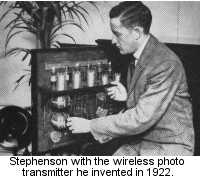
...
In London, Stephenson re-established contact with William Gladstone Murray,
a Canadian former fighter pilot who became Director of the Public Relations
for the BBC. To make radio more popular, accessible and successful, they
agreed that there was a need for reliable, reasonably priced receivers
suitable for home use by people with little or no interest in the technology
of radio reception. Staphenson decided to satisfy this requirement and started
his radio empire with the purchase of controlling interest in the General
Radio Company.
...
He was also associated with the development of the Spitfire, the fighter plane
which was to achieve such success in the defense of Britain in the early part
of the war.
Stephenson diversified into coal mining, oil refining, steel fabrication
and other industries, trading on a world wide basis. He had many dealings with
Germany and as early as 1933 he was expressing concerns about Hitler and the
developments in Nazi Germany.
Stephenson provided Winston Churchill with much of the data acquired on
Germany's developing advanced communication systems and on the millions of
pounds being spent on armaments. This information was presented to Neville
Chamberlain by Churchill, in the form of questions in the House. lt had bean
acquired in the course of normal business research by Stephenson's companies,
but it was William Stephenson who had recognized the significance.
Stephenson had become friends with H. G. Wells who predicted the future
wars would be like the science fiction of the 1930s, and the primary defense
would be information obtained and distributed rapidly. We saw this
situation in Desert Storm, but sixty years ago it was conjecture. Stephenson
agreed with Wells' concept and was concerned when he saw or heard about secret
communication developments in Germany. ENIGMA, the German coding machine for
messages was in use in 1934. It was several years before the coding system was
solved. Stephenson had commercial connections with ITT which manufactured
communications systems for the Nazis. It was this contact which made him aware
of Enigma soon after its introduction.
...
The scope of Stephenson's wartime activities will be the subject of future
meetings of
the Intrepid Society and I will not dwell on them. Suffice
it to say that
he was involved in directing and/or participating in special
operations, espionage, political manoeuvre and intrigue, politics, counter-intelligenca
and the efforts to encourage the USA to enter the war.
All of these activities were motivated by a patriotic loyalty to the Allied
cause. This was a the outward manifestation of his
support and belief in
the British Commonwealth, positive attitude and respect for the United States
and commitment to freedom and service to all the peoples of the world.
At the conclusion of hostilities, Stephenson received further recognition for
the work which he had done during the war. There were many arrangements to be
made for prominent individuals and issues to be investigated.
Consequently
the New York Office did not close until 9 months after the Japanese
surrendered in August 1945. However, prior to that, Stephenson had been
presented with a
knighthood by King George VI, announced in the King's New
Year's Honour List in January 1945.
After closing the New York office, Stephenson was still recognised in the US
as a major contributor to the Allied success in 1945.
He was awarded the
Presidential Medal of Merit the highest honour available to a civilian. This
was signed by President Truman, and was in recognition of the assistance given
by the British intelligence and special operations unit in developing the
American agency.
...
Stephenson moved to Jamaica and semi-retirement. However he was still
in contact with many prominent political and financial leaders and in
the
late 1940s and early 1950s he was involved with an international trading
group, the British-American-Canadian Corporation, later known as the World
Commerce Corporation, a group heavily involved in rehabilitation and
development of national economies which had suffered, or been deprived of
markets during the war. It particularly promoted barter trade
http://www.rclbr637.ca/sws.html
Although
Stephenson was knighted by King George VI and awarded the US Medal
for Merit, not much was known about his war services until the publication of
H. Montgomery Hyde's The Quiet Canadian (1962).
William Stevenson (no relative to Stephenson) later published 2 books about
him,
A Man Called Intrepid (1977) and
Intrepid's Last Case (1983).
...
Born in the Point Douglas area of Winnipeg, Manitoba, he left school at a
young age. In 1916 he volunteered for the 101st Battalion (Winnipeg Light
Infantry), CEF. He earned a field promotion to Sergeant and a medal for
battling in the trenches before he turned 19.
While recovering from being gassed in 1916, Stephenson learned to fly
and then transferred to the British Royal Flying Corps on August 16, 1917.
Posted to 73 Squadron on
February 9, 1918, Stephenson flew the British
Sopwith Camel fighter biplane and scored twelve victories, among them was
Lothar von Richthofen, the younger brother of the famous Red Baron, before
he was shot down and captured by the Germans on July 28, 1918.
By the end of World War I he had achieved the rank of Captain and earned
the Distinguished Flying Cross and the Military Cross.
http://www.nytimes.com/1989/02/03/obituaries/william-stephenson-british-spy-known-as-intrepid-is-dead-at-93.html
William Stephenson, British Spy Known as Intrepid, Is Dead at 93
By ALBIN KREBS Published:
February 03, 1989
...
Britain's World War II chief of intelligence in the Western Hemisphere were
chronicled in the 1979 bestseller ''A Man Called Intrepid'' died Tuesday in
Paget, Bermuda. He was 93 years old....
given the code name Intrepid by
Winston Churchill ...
Operating out of a suite in Rockefeller Center in New York, Sir William
sometimes served as a go-between for Churchill and Roosevelt and was
sent
potential American intelligence agents for training at secret bases in Canada.
Helped Organize O.S.S. He also helped in the organization of the United
States' wartime intelligence operation, the Office of Strategic Services,
whose head, Maj. Gen. William J. (Wild Bill) Donovan, later said: 'Bill
Stephenson taught us all we ever knew about foreign intelligence.''
http://www.amazon.com/quiet-Canadian-service-Stephenson-Intrepid/dp/0094687803
The quiet Canadian: The secret service story of Sir William Stephenson
(Intrepid) [Paperback]
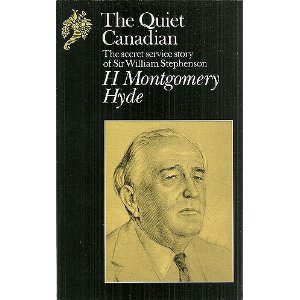
...
This 1962 book has a Foreword by Ian Fleming ("James Bond is not in
fact a hero, but an efficient and not very attractive blunt instrument in the
hands of government ... a highly romanticized version of the true spy")
who first met William Stephenson ("A Man Called Intrepid") when he
was on a mission to Washington in 1941. Stephenson was sent to New York in
1940 to protect British shipping of war material (and to gather information on
enemy activities for appropriate counter-measures), and
to promote public
opinion in favor of American intervention on the side of Britain. Any
offensive
actions would have to remain secret. This was part of Economic Warfare.
Chapter 2 documents the important political decisions made at the time by
President Roosevelt and others in 1940. Fifty coal burning destroyers were
sent to Britain at a critical time. The Sperry bomb-sight was leased after
they learned the Germans had the plans.
Chapter 3 tells of the propaganda campaign to discredit isolationists and
Nazi supporters, and the methods used to cripple or harass German
officials. Censorship of the mails was used to track down spies and saboteurs.
...
Chapter 6 tells of the OSS during WW2.
Stephenson
did everything to help Donovan get the position. The new organization
faced
two bureaucratic rivals: the FBI, and the military intelligence
departments. It was
mainly
through the assistance of BSC that they survived.
Intelligence and other
trained experts were put at Donovan's disposal.
It
explains how a short-wave station in Boston was used to broadcast propaganda.
http://www.bookrags.com/wiki/William_Stephenson
In recommending
Stephenson for knighthood, Winston Churchill wrote
"This One is Dear to My Heart."
Sources
British-born Canadian author William Stevenson (no relation) wrote a 1976
book A Man Called Intrepid about Stephenson. There are doubts about the
veracity of much of what he wrote.
Nigel West in Counterfeit Spies casts doubt on much of Stevenson's account;
the award of the Croix de Guerre avec Palmes and the Legion d'Honneur -
according to West no such record exists of either award.
John Colville (who was one of Churchill's private secretaries) in his 1981
book The Churchillians took issue with Stevenson's description of Stephenson's
relationship with Churchill during the war. He pointed out that Stephenson
was not Churchill's personal liaison with Roosevelt, that in fact (as is well
known) the two men corresponded directly and constantly. Indeed Colville never
heard Churchill speak of Stephenson at all.
There are however
numerous other references to the Stephenson-Churchill
connection in, for example,
Maclean’s magazine December 1, 1952, The Times October 21, 1962 and many
references to the relationship in Hyde’s biography The Quiet Canadian
(1962). Churchill was still alive.
British/Soviet double agent Kim Philby refers to Stephenson as a friend of
Churchill in his book My Silent War. Stephenson’s personal secretary and
personal cipher clerks talk of Stephenson-Churchill communication in the book
The True Intrepid and in the documentary Secret Secretaries. There is chapter
on the relationship in CIA historian Thomas Troy's Wild Bill and Intrepid.
Controversial historian David Irving in Churchill’s War reveals evidence
of a secret communications link between Roosevelt and Churchill that was run
by the FBI but controlled through Stephenson’s office.
There are references to this link in The True Intrepid. A dinner in
Stevenson's book at Lord Beaverbrook's house in May or June 1940 is highly
doubtful too. Colville described the printed letter of invitation from
Churchill as clearly an invention, since Churchill was punctilious and never
called Beaverbrook "the beaver", and for obvious reasons never
signed himself W.C. Lord Trenchard is described discussing his fighter
aircraft, where in fact it had been 10 years since Trenchard held a RAF post.
Colville's conclusion was to hope that Stevenson's book was not ever
"used for the purpose of historical reference." In the papers of
William Stevenson at the University of Regina there is only one reference to
the Beaverbrook dinner. Stephenson cables the author that he did not recall
the exact date of the gathering decades before, and there is no mention of him
receiving a written note invitation. (Macdonald page 372, Troy page 237) I
n a foreword to Richard Dunlop's Donovan, Stephenson writes he received a
telephone invitation to the dinner and he refers to "Boom Trenchard of
RAF and Scotland Yard fame."
A Man Called Intrepid (1979) (mini) TV Series .... Madelaine
http://www.videosurf.com/video/a-man-called-intrepid-peter-carter-1979-david-niven-barbara-hershey-gayle-hunnicutt-simon-york-1256922443
http://www.amazon.com/Intrepids-Last-Case-Helped-Tackles/dp/1585745219/ref=sr_1_fkmr2_1?ie=UTF8&qid=1306607945&sr=8-1-fkmr2
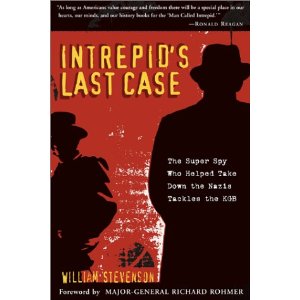 Intrepid's Last Case: The Super Spy Who Helped Take Down the Nazis Tackles
the KGB - 1983
Intrepid's Last Case: The Super Spy Who Helped Take Down the Nazis Tackles
the KGB - 1983 [Paperback]
Intrepid's Last Case chronicles the post-World War II activities of Sir
William Stephenson, whose fascinating role in helping to defeat the Nazis was
the subject of the worldwide best-seller A Man Called Intrepid.
Sir William Stephenson still stood at the center of events when he and author
William Stevenson discussed in the 1980s an investigation into
sudden
allegations that Intrepid's wartime aide, Dick Ellis, has been both a Soviet
mole and a Nazi spy. They concluded that the rumors grew, ironically, from
Intrepid's last wartime case involving the first major Soviet intelligence
defector of the new atomic age: Igor Gouzenko. Intrepid saved Gouzenko and
found him sanctuary inside a Canadian spy school, Camp X.
Gouzenko was
about to make more devastating disclosures than those concerning atomic
espionage when the case was mysteriously terminated and Intrepid's
organization dissolved.
Unraveling the implications of Gouzenko's defection and Intrepid's removal
from the case,
tracing the steps of Dick Ellis and disclosing much new
information regarding United States and Canadian postwar intelligence
activities, Intrepid's Last Case is a story that for sheer excitement
rivals the best spy fiction-and is all the more important because every word
is true.
Filled with never-before-revealed facts on the Soviet-Western nuclear war dance
and a compelling portrayal of the mind of a professional spy, Intrepid's Last
Case picks up where the first book ended, at the very roots of the cold war.
It
describes one of the most widespread cover-ups and bizarre betrayals in
intelligence history. (6 x 9, 356 pages)
http://www.amazon.com/True-Intrepid-William-Stephenson-Agents/dp/1894254015
 The True 'Intrepid': Sir William Stephenson and the Unknown Agents
[Hardcover
The True 'Intrepid': Sir William Stephenson and the Unknown Agents
[Hardcover]
The true story of Winnipeg born
William Stephenson (known as 'Intrepid'),
his career, and the secret World War II espionage organization, British
Security Coordination, which he established in the heart of New York City.
Truth can be elusive - especially during wartime.
Regarded as a founder of
the CIA by the organization's own historians, Stephenson has remained a
mysterious figure.
http://www.biographicon.com/view/9uw2i
...
On May 2, 2000 CIA Executive Director David W. Carey, representing Director
of Central Intelligence George Tenet and Deputy Director of Central
Intelligence John A. Gordon, accepted a bronze maquette (replica) statuette of
Sir William Stephenson, which was given to the CIA by the Intrepid Society of
Winnipeg, Manitoba.
In his remarks,
Carey said:
Sir William Stephenson played a key role in the creation of the CIA. He
realized early on that America needed a strong intelligence organization and
lobbied contacts close to President Roosevelt to appoint a U.S.
"coordinator" to oversee FBI and military intelligence.
He urged
that the job be given to William J. 'Wild Bill' Donovan, who had recently
toured British defenses and gained the confidence of Prime Minister Winston
Churchill. Although Roosevelt didn't establish exactly what Sir William had in
mind, the organization created represented a revolutionary step in the history
of American intelligence. Donovan's Office of Strategic Services (OSS) was the
first 'central' U.S. intelligence service. OSS worked closely with and learned
from Sir William and other Canadian and British officials during the war. A
little later, these OSS officers formed the core of the CIA. Intrepid may not
have technically been the father of CIA, but he's certainly in our lineage
someplace.

Sir William Stephenson still stood at the center of events when he and author
William Stevenson discussed in the 1980s an investigation into sudden
allegations that Intrepid's wartime aide, Dick Ellis, has been both a Soviet
mole and a Nazi spy.
They concluded that the rumors grew, ironically, from Intrepid's last wartime
case involving the first major Soviet intelligence defector of the new atomic
age: Igor Gouzenko. Intrepid saved Gouzenko and found him sanctuary inside a
Canadian spy school, Camp X. Gouzenko was about to make more devastating
disclosures than those concerning atomic espionage when the case was
mysteriously terminated and Intrepid's organization dissolved.
Unraveling the implications of Gouzenko's defection and Intrepid's removal
from the case, tracing the steps of Dick Ellis and disclosing much new
information regarding United States and Canadian postwar intelligence
activities, Intrepid's Last Case is a story that for sheer excitement
rivals the best spy fiction-and is all the more important because every word
is true
Assistant Secretary of State Adolf Berle did, though he was misled by
Ellis's cover name, as he passed this explosive information on to Sumner
Welles [remember him] : "For your confidential information, the
really active head of the intelligence section in Donovan's group is Mr.
Elliot, who is assistant to Mr. Stevenson [sic]. In other words, Stevenson's
assistant in The British intelligence is running Donovan's intelligence
service." (Mahl, pp. 18-19)
http://www.specialforcesroh.com/browse.php?mode=viewiaward&awardid=3830

https://deeppoliticsforum.com/forums/showthread.php?1057-Forefathers-of-the-CIA-Colonel-Charles-Howard-%93Dick%94-Ellis
Forefathers of the CIA: Colonel Charles Howard "Dick" Ellis
As any student of the Kennedy assassination well knows, there is endless
discussion of the CIA in the literature of the case, but as I observed early
on there is not much of value written about what the CIA actually is, where it
came from, or who it serves. So a few years ago I decided to do a little digging
and I eventually ended up presenting some of my findings in a talk to our local
JFK research group that I called "A History of the Origins of the
CIA."
One of the biggest surprises in my re-searching was to learn about a career
officer in the British Secret Intelligence Service (SIS) by the name of Dick
Ellis (1895-1975), who it was claimed, was actually running the two
predecessor American organizations to the CIA, the Coordinator of Information
office (1941-42) and the Office of Strategic Services (1942-45) for the official
head, William Donovan. And that was only the first of the big surprises.
One also learns that Dick Ellis, an Australian who joined the SIS in the mid
1920s, was later subjected to an investigation and hostile interrogation in
the UK to determine if he was a traitor of major proportions, who, it was
claimed, spied for the Germans before and during World War II and later for
the Soviet Union.
The information I had on this at the time contained in Thomas Troy's book
Wild Bill and Intrepid: Donovan, Stephenson, and the Origin of the CIA and Thomas
Mahl's Desperate Deception: British Covert Operations in the United States,
1939-44, was limited and inconclusive so I made a mental note to check later
to see if there might be something further in the ?spycatcher? books about
Ellis.
Well, I now have done a little more checking, and is there ever!
The most detailed exposure of the Dick Ellis story that I am aware of appeared
in the 1981 book by Chapman Pincher, Their Trade is Treachery, and there
is also much important coverage in Peter Wright's Spycatcher.
This is a long and complex story and there is one more important source that I
want to check on before going into any more detail so I will let this much serve
as a little introduction.
More to follow. Shortly, I hope.
I also hope to write up a little "Forefathers of the CIA" sketch about
Dick Ellis's boss during World War II, Sir William Stephenson, the famous
"Man Called Intrepid," who is of course a major part of the story.
There is also some great later information on him that I wasn't aware of either.
Ron Williams Last edited by Ron Williams; 03-17-2009 at 11:51 AM.
My Interest in Dick Ellis: The Books
I guess one way to attempt to explain how I got interested in Dick Ellis is to
recount how the first four of the main source books came into my hands, all on
the same day, and to present an extensive quote from one of them. The books are:
Wild Bill and Intrepid: Donovan, Stephenson, and the Origin of the CIA, by
Thomas F. Troy, 1996
Desperate Deception: British Covert Operations in the United States, 1939-44,
by Thomas E. Mahl, 1998
Room 3603: The Story of the British Intelligence Center in New York during
World War II, by H. Montgomery Hyde, 1962 (with a forward by Ian Fleming,
published in Canada and the UK as The Quiet Canadian)
British Security Coordination: The Secret History of British Intelligence in
the Americas, 1940-45, written for Sir William Stephenson by various BSC staff
members, 1945
Some seven or eight years ago when I was hoping to find some background on the
origins of the CIA I stopped into a used book store that I frequented at the
time and asked the cashier if they had a section on intelligence and espionage
and he pointed me to a shelf in a section of the store that I had overlooked in
previous visits. There in close proximity to one another were the above listed
four books. What they contained was beyond anything I had imagined, and here
specifically is what got me interested in Dick Ellis:
The influence of British Security Coordination in America to involve the
United States in World War II and to prepare the United States to participate in
war is impressive, even startling.
In the (Ernest) Cuneo Papers at the Franklin Roosevelt Library is an
article written by Cuneo that, while its main purpose was to defend Cuneo's
friend Dick Ellis from charges of being a Soviet mole, captures a telling
fact known to few people: British intelligence created William Donovan's COI/OSS.
If the charge against Ellis is true,? wrote Cuneo, "it would mean that
the OSS, and to some extent its successor, the CIA, in effect was a branch of
the Soviet KGB."
Cuneo is not the only insider to say bluntly that credit must fall to William
Stephenson's organization for the conception and establishment of the COI.
Stephenson cabled this to London in mid-June 1941: Donovan accuses me of having
'intrigued and driven' him into appointment. You can imagine how relieved I am
after three months of battle and jockeying for position in Washington that our
man is in a position of such importance to our efforts.?
Not only were the British the primary force in the conception and creation of
the COI, which later became the OSS and whose pieces were finally reconstructed
in the CIA, but a British officer, Dick Ellis, then ran the organization.
This was done in the deepest secrecy, because as Winston Churchill's personal
intelligence assistant, Major Desmond Morton, wrote, "It is of course
essential that this fact not be known in view of the furious uproar it would
cause if known to the Isolationists."
The isolationists never caught on, but Assistant Secretary of State Adolf
Berle did, though he was misled by Ellis's cover name, as he passed this
explosive information on to Sumner
Welles [remember him] : "For your confidential information, the
really active head of the intelligence section in Donovan's group is Mr. Elliot,
who is assistant to Mr. Stevenson [sic]. In other words, Stevenson's assistant
in The British intelligence is running Donovan's intelligence service." (Mahl,
pp. 18-19)
I had read the two Intrepid books when they first came out, but I had almost no
background at the time to help me appreciate what was in the second one,
Intrepid?s Last Case (1983). Only now in a rereading did I learn its main
purpose was an attempt by Sir William Stephenson to clear Dick Ellis?s name
eight years after his death. (More on this later.)
In the last week and a half or so I also skimmed through A Man Called Intrepid,
and read for the first time Spycather, Their Trade is Treachery, and a great and
startling book that I had not been aware of at all, The True Intrepid: Sir
William Stephenson and the Unknown Agents that was written in 1998 by Bill
Macdonald, a Canadian from Sir William?s home town of Winnipeg.
As I am not sure how to get to the end of this, I will leave it here for now,
and attempt to put together a basic biographical sketch of Dick Ellis in the
next post.
http://www.amazon.com/story-British-intelligence-center-during/dp/B00005XTNV/ref=sr_1_2?ie=UTF8&s=books&qid=1306612072&sr=1-2
Room 3603; the story of the British intelligence center in New York during
World War II [Hardcover]
H. Montgomery Hyde (Author)
Foreword by Ian Fleming. Story of the New York branch of British
intelligence known as the British Security Coordination during WWII. Based on
the papers of Sir William Stephenson, director of the office. The author was
also a member of the BSC.
Chapters include:
Spies, saboteurs and propagandists, the Vichy French, Special operations, COI
and OSS. Lots of fascinating 'inside stories' and accounts of famous figures
such as J. Edgar Hoover, Klaus Fuchs, Louis de Wohl (Hitler's astrologer,) Bill
Donovan, and the spy known only as "Cynthia." I found the material on
South American operations particularly interesting. Enough inspiration here for
lots of movies!
257 pages, bibliography and index.
http://satehate.exblog.jp/13590054
 MI-6
Charles "Dick" Ellis
MI-6
Charles "Dick" Ellis
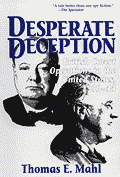
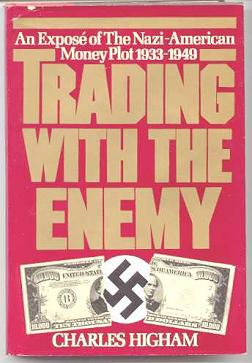
Desperate Deception: British Covert Operations in the US, 1939-44
http://adbonline.anu.edu.au/biogs/A140105b.htm
Ellis, Charles Howard (Dick) (1895 - 1975)
ELLIS, CHARLES HOWARD (1895-1975), soldier and intelligence officer, was
born on 13 February 1895 at Annandale, Sydney, second son of English-born
parents William Edward Ellis, clothing manufacturer, and his wife Lillian Mary,
née Hobday. After Lillian died in 1898, William took his sons to Brisbane and
Launceston, Tasmania, before settling in Melbourne about 1902. Completing his
education at Stott & Hoare's Business College, young Ellis worked for the
booksellers, Melville & Mullen Pty Ltd, and played oboe with the Royal
Melbourne Philharmonic Society. He sailed to Britain in June 1914, intending to
study there.
...
Having visited Melbourne in 1920, he began a course in Russian at St Edmund
Hall, Oxford, England. In 1922-23 he was a captain, Territorial Army Reserve,
based in Constantinople on intelligence work. At the British High Commission on
12 April 1923 he married a 17-year-old White Russian, Elizabeth (Lilia) Zelensky;
they were to have a son before being divorced. In December Ellis became British
vice-consul in Berlin: there and elsewhere he maintained surveillance on White
Russians fabricating intelligence documents for the British Special (Secret)
Intelligence Service (M.I.6) and probably joined the S.I.S. at this time. By
1926 he was employed by the British Chamber of Commerce in Vienna; as a
journalist with the London Morning Post, he reported from Geneva on sessions of
the League of Nations Assembly
...
Early in World War II, to attract support for Britain's cause and to monitor
German activities in the United States of America, the S.I.S. opened the
British Security Co-ordination office in New York. Bearing the official title of
British consul, Major Ellis was sent to the B.S.C. in 1940 as
assistant-director; in 1941 he became head of its Washington office. Some
American officials were eager to preserve their country's neutrality and opposed
the B.S.C., but the intelligence links it established bore fruit when the
U.S.A. entered the war in December.
Next year Ellis was in the Middle East where he worked with R. G. (Baron) Casey,
the British minister of state who was based in Cairo. Ellis rejoined the
B.S.C. in 1942 as a local colonel and returned to London in August 1944. He was
appointed to the U.S. Legion of Merit and C.B.E. in 1946.
Posted that year to the S.I.S.'s Singapore office as field-officer in charge
of South-East Asia and the Far East, he retained the post until his retirement
in 1953 when he was appointed C.M.G. On 24 August 1954 at the register
office, Kensington, London, he married a 48-year-old widow and retired
schoolteacher Alexandra Wood, née Surtees (d.1970).
In the 1950s he spent periods in his native-land, assisting with the
establishment of the Australian Secret (Intelligence) Service. He also helped to
found the journal, Hemisphere (1956), which focussed on Asian-Australian
affairs. His publications included The Transcaspian Episode, 1918-1919 (London,
1963), and he frequently contributed to the Journal of the Royal Central Asia
Society.
Allegations have been made that 'Dick' Ellis had passed information to German
intelligence before and during World War II, and that he could have worked for
Soviet intelligence while with the B.S.C. and subsequently.
Experts have dismissed these claims, if only because important information held
by Ellis was known not to have been transmitted to the Soviet Union.
http://en.wikipedia.org/wiki/Spycatcher
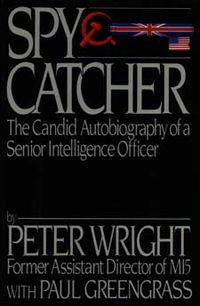
Spycatcher: The Candid Autobiography of a Senior Intelligence Officer
(also Spycatcher), is a book written by Peter Wright, former MI5 officer and
Assistant Director, and co-author Paul Greengrass. It was published first in
Australia. Its allegations proved scandalous on publication, but more so
because the British Government attempted to ban it, ensuring its profit and
notoriety
Spycatcher details the author’s work seeking to discover a Soviet mole in
MI5, and that the said mole
was Roger Hollis — a former MI5 Director General; it also describes
people who might have or might not have been the mole; and renders a history
of MI5 by chronicling its principal officers, from the 1930s to his time in
service.
Moreover, Spycatcher tells of the MI6 plot to assassinate President Nasser
during the Suez Crisis; of joint MI5-CIA plotting against left-wing British
Prime Minister Harold Wilson (secretly accused of being a KGB agent by the
Soviet defector Anatoliy Golitsyn); and of MI5’s eavesdropping on high-level
Commonwealth conferences.
...
The concepts and use of Public Key Infrastructure were discovered by British
scientists in GCHQ in 1969 with Ellis.
After the re-discovery and commercial use of PKI by Rivest, Shamir,
Diffie and others, the British government considered releasing the records
of GCHQ's successes in this field...
The primary case around which Spycatcher is based, that the Director General
of MI5 - Roger Hollis - was a Russian spy, is brought up-to-date by Chapman,
Pincher (2009), Treachery: Betrayals, Blunders, and Cover-ups: Six Decades of
Espionage Against America and Great Britain. New York: Random House
http://en.wikipedia.org/wiki/Roger_Hollis
...
Pincher claims Hollis was recruited by Richard Sorge in China in the early
1930s to spy for the GRU. Little evidence has been advanced to support these
assertions
Intrepid's last wartime case involving the first major Soviet intelligence
defector of the new atomic age: Igor Gouzenko. Intrepid saved Gouzenko and
found him sanctuary inside a Canadian
spy school, Camp X. Gouzenko was about to make more devastating
disclosures than those concerning atomic espionage when the case was
mysteriously terminated and Intrepid's organization dissolved.
http://www.thecanadianencyclopedia.com/index.cfm?PgNm=ArchivedFeatures&Params=a221
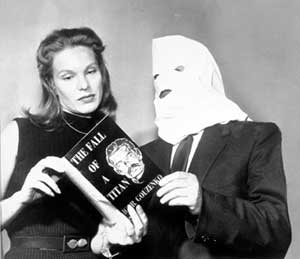
Igor Gouzenko on television, 1966. Over half of the convictions under the
Official Secrets Act were a result of Gouzenko's defection (courtesy NAC/PA-129625).
...
He” was Igor Gouzenko, a cipher clerk at the Soviet embassy in Ottawa, and it
was September 6, 1945, the day after he left the embassy carrying 109 secret
documents under his shirt. Soviet agents had come to take him in. Gouzenko was
protected by his Canadian neighbour, who got him and his family to safety,
called the police and told the agents when they returned that the Gouzenkos were
away.
Gouzenko asserted that the USSR maintained an extensive spy ring in Canada,
aimed mostly at obtaining atomic secrets. Furthermore, Gouzenko warned,
the Soviets were not allies but were planning world domination. Gouzenko’s
revelations shattered the innocence of the naïve Canadian populace.
His defection initiated the
Cold War between the Soviets and the West and led to the creation of NATO and
the Warsaw Pact.
Gouzenko’s autobiography This Was My Choice details Russian life under
Stalin. The conditions young Igor faced are unfathomable to most Canadians.
Deprivation and poverty took its toll on the Soviet people. They were worn down
by the cruelty and tyranny of the Communist government whose history, written in
the blood of its people, comprises purges, concentration camps, mass executions
and torture.
...
Gouzenko was transferred to Intelligence Headquarters in Moscow, where he
observed a network of Communist spooks from all over the world. He was sent
to Ottawa in 1943. In Canada he found a land of plenty, a land he did not
want to leave when he learned he would be sent back to Moscow. He also
discovered the extensive spy ring operated by Colonel Zabotin.
http://www.documentstalk.com/wp/guzenko-gouzenko-igor-sergeevich-1919-1982

Igor Gouzenko at Camp X, 1948
Code name “Clark.” A Soviet cipher clerk in Ottawa, Canada who
defected in September 1945. Guzenko was born in a village in the Moscow region
and studied at Moscow Architectural Institute and at the Military Engineering
Academy. After graduating from cipher clerk training school in April 1942, he
began work as a cipher clerk at GRU headquarters in Moscow.
In August 1943, Guzenko was posted to Ottawa as a cipher clerk in the office of
the Soviet military attaché in Canada, who was also a resident of the GRU.
On September 5, 1945, Guzenko defected with documentation he had hidden away in
preparation for his defection. The evidence he provided revealed Soviet
espionage penetration in Canada, with leads to Great Britain and the United
States, and led to arrests and espionage prosecutions with 18 convictions in
Canada.
Guzenko and his family were given another identity and settled in Canada. For
years, however, Guzenko remained in the public eye, appearing in photos and on
television with a hood over his head.
http://www.spartacus.schoolnet.co.uk/SSskardon.htm
http://www.spartacus.schoolnet.co.uk/SSgouzenko.htm
...
Igor Gouzenko was born in Russia on 13th January, 1922. He worked as a cipher
clerk in the Russian Legation in Ottawa, Canada. This was only a cover as he was
really a KGB intelligence officer.
On 5th September 1945, Gouzenko defected to the West claiming he had evidence
of an Soviet spy ring based in Britain. The case was passed on to Kim
Philby, head of Section IX (Soviet Affairs) of MI6. He suggested that
Gouzenko should be interviewed by Roger Hollis of MI5.
Gouzenko provided evidence that led to the arrest of 22 local agents and 15
Soviet spies in Canada. Information from Gouzenko resulted in the arrest and
conviction of Klaus Fuchs and Allan Nunn May.
Gouzenko also claimed that there was a Soviet agent inside MI5. However,
he was later to argue that Hollis showed little interest in this evidence.
"The mistake in my opinion in dealing with this matter was that the task of
finding the agent was given to MI5 itself. The results even beforehand could be
expected to be nil."
I hope I'm not off base on this, but I was told and at one time had information
that two Japenese emissarys with a declaration of war were detained, not
allowed access, etc in possession of a declaration of war,days before Pearl
Harbor.
Some guy said , show me who profits from the war and we can stop war, or
words to that effect.
Power, money, prestige, nobility, royalty, dynamic egos, etc. is
all the sametub of Shiiiite.
I seem to remember seeing somewhere that the delagation was delayed (possibly by
HULL).
Notice they did everything they could to get the Japanese to strike the U.S. and
not the U.S.S.R, First.
If you go back into it, via Sorge spies, et.al the U.S.S.R already knew that
Japan had been convinced at least to wait and prepare a strike against the U.S.
in June 1941. Hitler knew too, and unleashed a Blitzkreig of tanks against the
U.S.S.R. in June 22 1941,
Hitler's plan was for the Japanese to strike against the U.S.S.R. to create a
two front war against them ((for Good or Bad) They might have won) But all the
pre-war espionage pushed Japan to go South and East against the U.S. and the
Philipines/Indonesa... Hitler continued to ask Japan to attack the U.S.S.R. to
create the two front war against the U.S.S.R but the Sorge spy ring was too
influential.
http://en.wikipedia.org/wiki/Operation_Barbarossa
- June 22, 1941 – December 5, 1941
On November 25, 1941, twelve days before Pearl Harbor, Lattimore dispatched
an anxious cable to Currie in the White House arguing against a proposed
diplomatic understanding between the United States and Japan. When Congress
later investigated the Pearl Harbor attack,
U.S. Secretary of State
Cordell Hull testified that he took a tough line with the Japanese because
of this cable from Lattimore to Currie reporting on Chinese morale in the
Kuomintang. This cable was the only documentary evidence Hull presented which
influenced his decision to reverse himself and send the ultimatum to Japan.
http://www.awesomestories.com/assets/intercepted-decoded-message-november-28-1941
This message was intercepted, and decoded, by the United States. It was sent
from Tokyo to Japan's emissaries in Washington - ten days before the Pearl
Harbor attack.
[Secret]
From: Tokyo
To: Washington
November 28, 1941.
Purple (CA)
#844
Re your #1189 [a]
Well, you two Ambassadors have exerted superhuman efforts but, in spite of this,
the United States has gone ahead and presented this humiliating proposal. This
was quite unexpected and extremely regrettable. The Imperial Government can by
no means use it as a basis for negotiations. Therefore, with a report of the
views of the Imperial Government on this American proposal which I will send you
in two or three days, the negotiations will be de facto ruptured. This is
inevitable. However, I do not wish you to give the impression that the
negotiations are broken off. Merely say to them that you are awaiting
instructions and that, although the opinions of your Government are not yet
clear to you, to your own way of thinking the Imperial Government has always
made just claims and has borne great sacrifices for the sake of peace in the
Pacific. Say that we have always demonstrated a long-suffering and conciliatory
attitude, but that, on the other hand, the United States has been unbending,
making it impossible for Japan to establish negotiations. Since things have come
to this pass, I contacted the man you told me to in your #1180 and he said
that under the present circumstances what you suggest is entirely unsuitable.
From now on do the best you can.
http://homepage.ntlworld.com/andrew.etherington/1941/12/08.htm
...
2:25 AM: Japanese air raid on Pearl Harbor commences
2:28 AM: Pearl Harbor sends en clare radio message to Navy Department,
"AIR RAID PEARL HARBOR STOP THIS IS NO DRILL STOP END". (The
message was drafted by Rear Admiral Patrick N L Bellinger, Naval Base defence
Air Force Commander, 14th Naval District, though it does not seem to have been
recorded whether his signature or, for that matter, any signature, was appended
to this message.)
3:20 AM: (2:20 PM December 7, Washington time) Japanese
emissaries deliver declaration of war to Hull.
U.S.A. President Roosevelt speaks before the US Congress requesting a
declaration of war against Japan declares December 7 to be: "a date which
will live in infamy." In just eight minutes President Roosevelt today
called on the Congress of the United States to declare war on Japan. It took a
further 20 minutes for congressmen to vote America into the world conflict.
http://en.wikipedia.org/wiki/Hull_note
The Hull note or officially Outline of Proposed Basis for Agreement Between
the United States and Japan was the final proposal delivered to the Empire of
Japan by the United States before the attack on Pearl Harbor and the
declaration of war between the two nations. The note was delivered on November
26, 1941; it is named for Secretary of State Cordell Hull.
...
On
November 25 Henry L. Stimson, United States Secretary of War noted in
his diary that he had discussed with US President Franklin D. Roosevelt the
severe likelihood that Japan was about to launch a surprise attack, and
that the question had been "how we should maneuver them [the Japanese]
into the position of firing the first shot without allowing too much danger to
ourselves.'"[4][5]
On the following day,
November 26, 1941, Hull presented the Japanese
ambassador with the Hull note, which as
one of its conditions demanded
the complete withdrawal of all Japanese troops from French Indochina and China.
It did not refer to Manchukuo, in which hundreds of thousands of Japanese
civilians were already living.
Japanese Prime Minister Tojo Hideki said to his cabinet, "this is an
ultimatum."[6]
The strike force which attacked Pearl Harbor had set sail the day before,
on the morning of November 26, 1941, Japan time. It could have been
recalled along the way, but no further diplomatic progress was made and
On
1 December, Emperor Hirohito approved, in Imperial Conference, the war
against United States, Britain, and the Netherlands, which began by the attack
on Pearl Harbor, Malaya, and the Philippines.[7]
Tahoe.
I could rant on this one
bro. Just one point, an entire Japanese fleet is not noticed by anyone on
the earth or sea. A hawain newspaper ,front page, warned of the Japanese
attack, days before.
These newspapers were sought out by intell agents and destroyed,
though they missed a few, I beleive they can be researched on this site.
911, not a Pearl attack, but a facsile therof.
Exactly - I'll update this post with a link to thread when I find it.
Germar
Rudolf
 What
really happened - Honolulu Advertiser
http://www.ihr.org/jhr/v04/v04p388_Stimely.html
What
really happened - Honolulu Advertiser
http://www.ihr.org/jhr/v04/v04p388_Stimely.html
...
Joseph Leib, a former New Deal bureaucrat and retired newspaper
correspondent, wrote an article which appeared in Hustler magazine,
"Pearl Harbor: The Story the Rest of the Media Won't Tell," in which
he claimed that his friend, Secretary of State Hull, had confided to him
on 29 November 1941 that J. Edgar Hoover and FDR knew that the Japanese were
going to attack Pearl Harbor withing a few days, and that the President, over
Hull's strident objections, was going to let this happen as a way to get the
country into war.... Leib's story was not the capstone to the recent
revisionist wave...
http://aotearoaawiderperspective.wordpress.com/2008/04/29/explosive-truth-about-pearl-harbor-the-story-the-rest-of-the-media-wont-tell/
EXPLOSIVE TRUTH ABOUT PEARL HARBOR: THE STORY THE REST OF THE MEDIA WON’T
TELL- JOSEPH LEIB
...
How could the Japanese fleet sail across the Pacific without detection?
Where did Japan obtain the detailed information about the deployment of U.S.
forces on Oahu?
Why were our ships and planes lined up so neatly together, inviting attack?
How could our fighting forces be caught so off-guard?
How could they be taken so totally by surprise?
...
A full week earlier, on
November 29, I learned about the impending attack
from an unlikely source – Cordell Hull, Roosevelt’s own secretary of
state. To put the matter into proper perspective, I should explain how and why
Hull came to entrust me with the terrible secret of Pearl Harbor.
...
Hull began to talk. His words came slowly at first and then fairly streamed
from his mouth. It was as if he could barely wait to pronounce them he was so
anxious to tell the story.
I could only sit in startled silence as
Hull told me Japan was going to
attack Pearl Harbor within a few days, and pulled from his inside coat pocket
a transcript of Japanese radio intercepts detailing the plan. Recovering
from my shock, I began to question him.
“Why are you telling me this?” I blurted out. “Why don’t you hold a
press conference and issue a warning?”
“I don’t know anyone else I can trust,” he replied, shaking his head.
“I’ve confided in some of your colleagues in the past, but they’ve
always gotten me into hot water. You’ve had the goods on me for months; yet
you’ve kept your promise not to publish them. You’re the only one I can
turn to.”
“Does the President know the Japs are going to attack Pearl Harbor?”
“Of course he does. He’s fully aware of the plans. So is Hoover at the
FBI. Roosevelt and I got into a terrible argument, but he refuses to do
anything about it. He wants us in this war, and an attack in Hawaii will give
him just the opportunity. That’s why I can’t hold a press conference.
I’d be denounced by the White House. No one would believe me!”
(Hull’s allegations about FBI complicity in the coverup were confirmed more
than a month after Pearl Harbor. A bylined article by United Press reporter
Fred Mullen in the Washington Times-Herald declared, “FBI Told Army Japs
Planned Honolulu Raid.” The article explained that the bureau had
intercepted a radio-telephone conversation on December 5, which mentioned
details of the planned raid. Within hours of publication Hoover pressured the
newspaper into pulling the story from its later editions.)
After exacting a promise from me never to reveal where I got the document,
Hull gave me a transcript of the Japanese message intercepts. I nearly ran the
few short blocks to the National Press Building on 14th Street, where I had an
office. I took the elevator up to the United Press bureau and brushed past the
clerks and reporters into Lyle Wilson’s private office.
...
The only newspaper in the whole world to use any portion of the story was the
Honolulu Advertiser.
A front-page banner headline in the paper the morning
of Sunday, November 30, “JAPANESE MAY ATTACK OVER WEEKEND!” A subhead
noted, “Hawaii Troops Alerted”.
Suspiciously, the story didn’t mention that the target of the Japanese
attack would be Pearl Harbor itself. The horrible cost paid for that simple
omission is well-known.
| -- - -- - -
What I am trying to show (and research the history of) these NWO networks
were set up before WWII and continue to this day (post 911) - Tell me it ain't
so Joe....

Life Sept 1945 - Colonel Jimmy Stewart Cover -
Dewey knew [found out] the full story of Pearl Harbor in the autumn 1944:
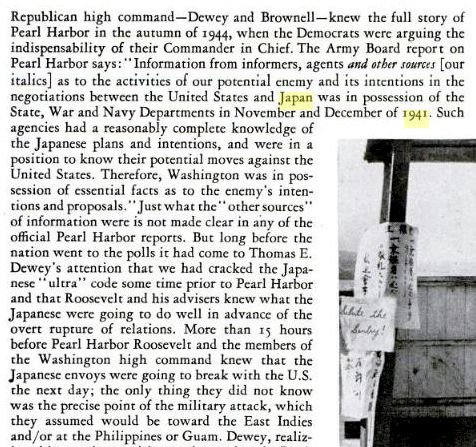 LIFE
- Sept_1945 The Hull Note
LIFE
- Sept_1945 The Hull Note
[
Keep in mind that Life was owned and published by Henry Luce and he certainly
knew what was going on, he was backing Shek in China while the CFR's are backing
Mao. It seems these elites want the same things, ruling the world, there's just
a disagreement to the body count and which bodies.
Think about what emboldened Hitler and ToJo and Mussolini. What made them think
they could take on the world and murder millions? It started with the Russian
revolution and the communist purges, they murdered the czar and anyone that got
in there way, then they got in power and murdered more and starved millions of
others. That was the story for twenty years in the U.S.S.R. with Lenin/Stalin.
So they got away with it. And because they got away with it. These other
dictators felt they could do it to. Of course they were encouraged to via
Rockefeller/Rothschild financing who just by no coincidence financed the
communist revolution in Russia in the first place (Lenin on the train with
the gold box cars)...
]
Vladimir
Lenin received $12,000,000 in gold bullion from the Jacob Schiff’s Kuhn
Loeb & Company bank in New York City. Lenin was shipped from Zurich,
Switzerland to Russia in a sealed boxcar. This gold bullion in the hands of
skilled organizers soon led to toppling of the Russian monarchy. Thus U.S.
financial interests played a significant role in bring about Russia’s
communist revolution. which spread to involve the whole world
Jacob
Schiff was head of the New York investment firm Kuhn, Loeb and Co. He was
one of the principal backers of the Bolshevik revolution and personally financed
Trotsky's trip from New York to Russia. He was a major contributor to Woodrow
Wilson's presidential
campaign and an advocate for passage of the Federal Reserve Act.
Jacob
Schiff, head of Kuhn, Loeb and Co. (now Chase Manhattan)
http://en.wikipedia.org/wiki/Life_(magazine)
In 1936 publisher Henry Luce paid $92,000 to the owners of Life magazine because
he sought the name for Time Inc.
...
Life got its own building at 19 West 31st Street, a Beaux-Arts architecture
jewel built in 1894 and considered of "outstanding significance"
by the New York Landmarks Preservation Commission.
Later it moved editorial offices to 9 Rockefeller Plaza.
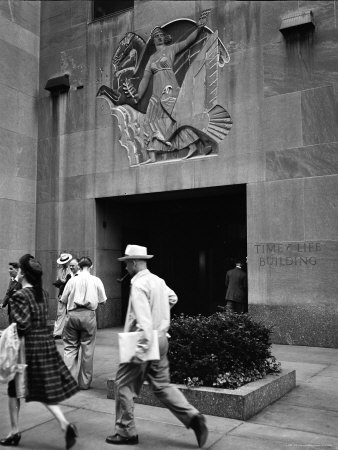 9 Rockefeller Plaza
9 Rockefeller Plaza
Oh and more about "30 Rock" built by Rockefeller in the 1930's
DEPRESSION (So what did he see in HIS crystal ball?):
http://en.wikipedia.org/wiki/Rockefeller_Center
Rockefeller Center or Rockefeller Plaza is a complex of 19 commercial
buildings covering 22 acres (89,000 m2) between 48th and 51st streets in New
York City, United States. Built by the Rockefeller family, it is located in
the center of Midtown Manhattan, spanning the area between Fifth Avenue and
Sixth Avenue. It was declared a National Historic Landmark in 1987
...
Rockefeller Center was named after John D. Rockefeller, Jr., who leased the
space from Columbia University in 1928 and developed it from 1930. Rockefeller
initially planned a syndicate to build an opera house for the Metropolitan Opera
on the site, but changed his mind after the stock market crash of 1929 and the
Metropolitan's continual delays to hold out for a more favorable lease, causing
Rockefeller to move forward without them.
...
It was the public relations pioneer Ivy Lee, the prominent adviser to the
family, who first suggested the name "Rockefeller Center" for the
complex, in 1931. Junior initially did not want the Rockefeller family name
associated with the commercial project, but was persuaded on the grounds that
the name would attract far more tenants.[8]
What could have become a major controversy in the mid-1930s concerned the last
of the four European buildings that remained unnamed. Attempts were made by Ivy
Lee and others to rent out the space to German commercial concerns and name it
the Deutsches Haus. Junior ruled this out after being advised of Hitler's Nazi
march toward World War II, and thus the empty office site became the
International Building North.[9]
This subsequently became the primary location of the U.S. operations of British
Intelligence, British Security Coordination (BSC) during the War, with Room 3603
becoming the principal operations center for Allied intelligence, organized by
William Stephenson, as well as the office of the future head of what was later
to become the Central Intelligence Agency, Allen Welsh Dulles.[10]
The Center is a combination of two building complexes: the older and original
14 Art Deco office buildings from the 1930s, and a set of four
International-style towers built along the west side of Avenue of the Americas
during the 1960s and 1970s (plus the Lehman Brothers Building). (The
Time-Life Building, McGraw-Hill and News Corporation/Fox News Channel
headquarters are part of the Rockefeller Center extension now owned/managed
by the major private real estate firm, Rockefeller Group.)
In 1985, Columbia University sold the land beneath Rockefeller Center to the
Rockefeller Group for 400 million dollars.[11]
The entire Rockefeller Center complex was purchased by Mitsubishi Estate, a
real estate company of the Mitsubishi Group, in 1989, which fully bought out
Rockefeller Group.
In 2000, the current owner Jerry Speyer (a close friend of David
Rockefeller), of Tishman Speyer Properties, L.P., together with the Lester Crown
family of Chicago, bought for $1.85 billion the older 14 buildings and land from
the previous syndicated owners: Goldman Sachs (which had 50 percent ownership),
Gianni Agnelli, Stavros Niarchos, and David Rockefeller, who organized the
syndicate in 1996 and is historically associated with the other partners.[12]
Just a thought. Ya think, the "FitzGerald" Kennedy's discussed
politics around the dinner table? Ya think ?
http://en.wikipedia.org/wiki/Joseph_P._Kennedy,_Sr.
During World War I, he was an assistant general manager of Bethlehem Steel
and developed a friendship with Franklin D. Roosevelt, then Assistant Secretary
of the Navy.
...
At the repeal of Prohibition, Kennedy and FDR's son James Roosevelt traveled
to Scotland to buy distribution rights for Scotch whisky.
...
He was the inaugural Chairman of the U.S. Securities and Exchange Commission
(SEC), appointed by President Franklin D. Roosevelt (FDR), and later directed
the Maritime Commission. Kennedy served as the United States Ambassador to the
United Kingdom from 1938 until late 1940, including the early part of World
War II.
...
His term as Ambassador and his political ambitions ended abruptly during the
Battle of Britain in November 1940, with the publishing of his controversial
remarks suggesting that "Democracy is finished in England. It may be here,
[in the US]." Kennedy resigned under pressure shortly afterwards.
http://www.jfklibrary.org/JFK/The-Kennedy-Family/Joseph-P-Kennedy.aspx?p=3
...
In 1933, with the election won and Roosevelt inaugurated, Kennedy took a trip
to Europe with James Roosevelt, the new President’s son. The end of
Prohibition had been implicit in Roosevelt’s election, and Kennedy saw in it a
new business possibility. While in England he obtained rights to become the U.S.
agent for Haig & Haig Ltd., John Dewar and Sons, Ltd. and Gordon's Dry Gin
Company Ltd. When Prohibition officially ended, with the ratification of the
21st amendment, Kennedy and his company, Somerset Importers, were poised to take
advantage of the country’s rehabilitated thirst with an enormous stockpile of
liquor imports.
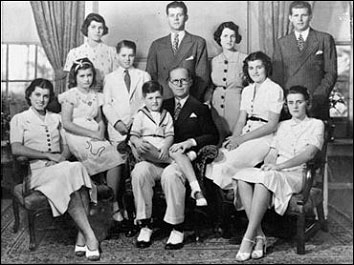
Mr. and Mrs. Joseph P. Kennedy with their nine children in Bronxville, N.Y.,
1938. From left are, seated: Eunice, Jean, Edward (on lap of his father),
Patricia, and Kathleen. Standing: Rosemary, Robert, John, Mrs. Kennedy,
and Joseph, Jr.
http://en.wikipedia.org/wiki/Why_England_Slept

Why England Slept (ISBN 0-313-22874-4) is the published version of a thesis
written by John F. Kennedy while in his senior year at Harvard College. Its
title was an allusion to Winston Churchill's 1938 book While England Slept,
which also examined the buildup of German power. Published in 1940,[1] the
book examines the failures of the British government to take steps to prevent
World War II and is notable for its uncommon stance of not castigating the
appeasement policy of the British government at the time, instead suggesting
that an earlier confrontation between the United Kingdom and Nazi Germany could
well have been more disastrous in the long run.
...
As ambassador to Britain, Joseph P. Kennedy Sr. supported Prime Minister
Neville Chamberlain's policy of appeasement during the late 1930s. John F.
Kennedy lived with his father in Britain at that time and witnessed the
Luftwaffe's bombings of Britain first-hand.
The book's introduction was
written by Henry R. Luce.
We never here much about James Roosevelt - he survived the war:
http://en.wikipedia.org/wiki/James_Roosevelt
James Roosevelt (December 23, 1907 – August 13, 1991) was the oldest son of
U.S. President Franklin D. Roosevelt. He was a U.S. Representative, officer
in the United States Marine Corps, aide to his father, official Secretary to the
President, Democratic Party activist, and businessman.
...
In October 1939, after World War II broke out in Europe, Roosevelt resigned the
lieutenant colonel's commission he had been given in 1936, and was commissioned
as a Captain in the Marine Corps Reserves. In November 1940, he went on active
duty. In early 1941, the President sent him to the Middle East as a military
attaché with the British forces. He travelled extensively in the area, and
observed several important campaigns. [3]
In August 1941, he joined the staff of William J. Donovan, Coordinator of
Information, with the job of working out the exchange of information with other
agencies.[1]
After Japan's Attack on Pearl Harbor, Roosevelt requested assignment to
combat duty. He transferred to the Marine Raiders, the Marines' commando force,
and became second-in-command of the 2nd Raider Battalion under Evans Carlson who
Roosevelt knew when Carlson commanded the Marine Detachment at the Warm Springs,
Georgia residence of Franklin Roosevelt. His influence helped win Presidential
backing for the Raiders, who were opposed by Marine traditionalists.
Roosevelt served with the 2nd Raiders at Midway, and in the Makin Island
raid, where he earned the Navy Cross. He was given command of the new 4th
Raiders, but was invalided in February 1943. He served in various staff
positions during the rest of the war. In November 1943, he accompanied Army
troops in the invasion of Makin, and was awarded the Silver Star by the Army.
He retired from active duty in October 1945, with rank of Colonel.
He continued in the Marine Corps Reserves, and retired in 1959 at the rank of
Brigadier General.[3]
James suffered from having flat feet, so while other Marines were required to
wear boots, he was allowed to wear sneakers
http://worldwar2history.info/Pearl-Harbor/deceit.html
...
Donovan had not been present at dinner but had been summoned by the President
from New York, where he had been watching a football game at the Polo Grounds.
Football fans heard an unusual announcement over the public address system about
2:30 that afternoon: "Colonel William Donovan, come to the box office at
once. There is an important phone message." The message was from James
Roosevelt, the President's son and a member of Donovan's staff; he told Donovan
about the Japanese attack.
Throughout the evening of December 7, Roosevelt conferred with congressional and
military leaders. He decided his first wartime move would come the next morning,
December 8, when he would ask Congress to declare that a state of war existed
between Japan and the United States. He prepared a rough draft of what later
became his "Day of Infamy" speech.
Then he invited Murrow and Donovan into the study for a midnight snack of
sandwiches and cold beer. Chief Usher Crim noted that the three men spent
twenty-five minutes together in the study before Roosevelt retired to his
adjoining bedroom. Crim's arrival and departure notations in the Usher Book
comprise the only official record; there were no official minutes of the
meeting.
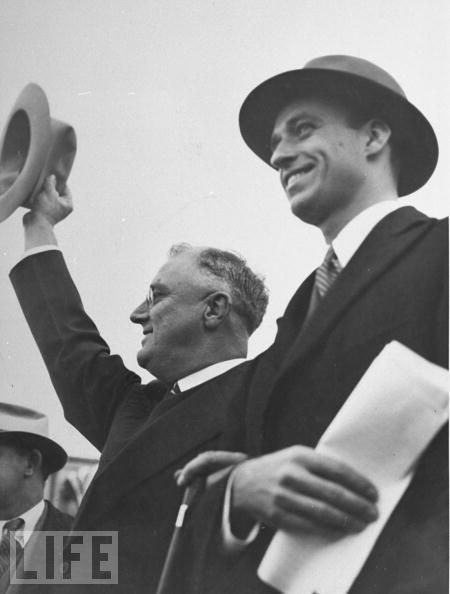 FDR
and son James
FDR
and son James
http://www.corbis.co.in/searchresults.php?s=Joseph+Patrick+Kennedy&rm=&rf=&mr=&loc=&col=&listRF=&orient=&view=&people=&pht=&max=1000&p=1

Joseph Patrick Kennedy and James Roosevelt Standing Outside
Original caption: Pictured as they chatted at Palm Beach,
Florida, are James Roosevelt, (L), son of the President, and Joseph P. Kennedy,
the U. S. Ambassador to Great Britain. James Roosevelt was a guest at the
Kennedy Palm Beach Home. The new envoy was expected to sail for his new post in
England on February 26, 1938.
http://en.wikipedia.org/wiki/Marine_Raiders
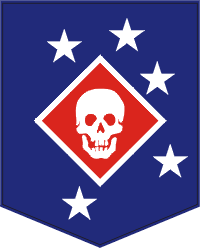
...
The Raiders were created by an order from President Franklin D. Roosevelt,
acting on proposals from Colonel William J. Donovan and Major Evans F. Carlson.
Carlson had been a soldier in the Punitive Expedition to capture Pancho Villa in
Mexico and World War I, became a Marine officer during the American occupation
of Nicaragua, and served as an Intelligence Officer of the 4th Marines in
China.
He had seen the tactics and strategy of Communist Chinese irregulars, Zhū
Dé and the Eighth Route Army in particular, as they fought the occupying
Japanese and became enthralled with their version of guerrilla warfare.
In 1933 Carlson had commanded the Marine Detachment at the Warm Springs,
Georgia vacation retreat of President Roosevelt, where he formed a close
friendship with both Franklin D. Roosevelt and his son James.
Carlson resigned from the Marines to speak to American businessmen to warn them
against providing materials to Japan.
Carlson rejoined the Marines in April 1941, gaining a commission from the
Commandant as a reserve major. Carlson still had the President's ear as well as
FDR's son James Roosevelt, who was now a Marine Captain and was his friend and
protégé.
The Raiders were given the best of the Marines' equipment, and were handpicked
from available volunteers. The two units approached their common mission from
different directions. Carlson utilized egalitarian and team-building methods
learned from the Communists during his years in China: he treated officers and
enlisted men with minimum regard to rank as leaders and fighters, gave his men
"ethical indoctrination," describing for each man what he was fighting
for and why, and used the Chinese phrase "Gung-ho!" as a
motivational slogan. He also eschewed standard Marine Corps organization,
forming six rifle companies of two platoons each, and innovating 3-man
"fire teams" as its basic unit.[4] Edson's battalion, however, more
closely followed standard Marine Corps doctrine in training, organization, and
discipline.

United States Marines of the Second Raider Battalion gather around officers
(kneeling left to right) Lt. Col. Evans F. Carlson, Capt. M.C. Plumley,
and Maj. James Roosevelt as they plan an attack during the Makin
Island raid, one of America's earliest offensives in the Pacific during
World War II.
http://en.wikipedia.org/wiki/Evans_Carlson
...
Friendship with the Roosevelts
Returning to the United States in 1933, Captain Carlson served as executive
officer of the Marine Corps Detachment at President Roosevelt's alternative
White House and vacation retreat at Warm Springs, Georgia where he became
closely acquainted with President Franklin D. Roosevelt and his son James.
[edit] Second and third China tours
After his Warm Springs tour Carlson was posted to the 4th Marines in Shanghai.
Shortly afterward he was transferred to the Marine Detachment, American
Legation, Peiping, China, where he served as Adjutant and studied the Chinese
language. In 1936, he returned to the United States via Japan. At home he served
at Quantico while attending Marine Corps Schools, and studying International Law
and Politics at George Washington University in Washington, D.C.
He went back to China for the third time in 1937 as an official student of the
Chinese language and as a military observer with Chinese forces. There he was
afforded the opportunity to learn the tactics of the Japanese soldier.
He met Edgar Snow in China and read Snow's Red Star Over China. This
encounter led him to visit the Chinese communist troop headquarters in northern
China, where he met Chinese Communist leaders such as Mao Zedong, Zhou Enlai and
Deng Xiaoping. Traveling thousands of miles through the interior of China
with the communist guerrillas, often on foot and horseback over the most
hazardous terrain, he lived under the same primitive conditions. He was
impressed by the tactics used by Chinese Communist guerrillas to fight Japanese
troops.
When he left China in 1938, he was commended by the Commander in Chief of the
Asiatic Fleet for his services. He was so impressed with the danger of Japanese
aggression in the Far East that in 1939 he resigned his commission as a captain
in order to be free to write and lecture on that subject
...
Brigadier General Evans Fordyce Carlson (26 February 1896 – 27 May
1947) was the famed U.S. Marine Corps leader of the World War II
"Carlson's Raiders". He is renowned for the "Makin Island
raid" on August 17, 1942 and their "Long Patrol" (aka
Carlson's patrol or Carlson's Raiders) from November 4, 1942 to December 4, 1942
behind Japanese lines on Guadalcanal, in which 488 Japanese were killed, 16
Raiders were killed and 18 wounded, during the Guadalcanal campaign. Carlson
is also credited with first coining the term "Gung-ho" as it is
most popularly used today.
http://www.cpaffc.org.cn/yszz/detaile.php?subid=778&id=337
Rewi Alley - Great New Zealander in China
...
In 1939, Rewi Alley paid two visits to Yan’an and met Chairman Mao Zedong
four times. In his old age, he still remembered well that he was asked in
particular to find ways and means for producing grenades to support General He
Long’s troops fighting in the northwest. Earlier in Wuhan, Rewi Alley met
with Communist leaders Zhou Enlai and Bo Gu, who made suggestions and
expressed hopes for the development of Gung Ho. Wang Bingnan was sent to take
part in several meetings held by Gung Ho in its initial period.
Rewi Alley’s mind was very much on the southeast area where the New
Fourth Army was waging fierce battles with the Kuomintang armies. In early 1939,
he took charge of the Gung Ho Southeast Headquarters personally, and in
1940 he was invited by the Snows to the Philippines to raise fund for the work
of Gung Ho in the New Fourth Army area in particular.
Later, together with Evans Carlson, a former US marine officer and now
representative of the US Committee for the Promotion of Chinese Industrial
Cooperatives, visited and revisited the New Fourth Army area, where they met
Communist leader Liu Shaoqi near the army headquarters.
After the outbreak of the Pacific War, Carlson wrote to President Roosevelt
and won his approval for organizing the Raider Battalion known as Carlson’s
Raiders of the US Marine Corps. Using Gung Ho as its battle cry, this
special fighting force, with Roosevelt’s son and his own son in it, adopted
the surprise-attack tactics of the Eighth Route Army and won splendid
victories over the Japanese army on Makin Island and on Guadalcanal, making its
name known throughout the United States.

Edgar Snow and Evans Carlson Phillippines 1940
http://www.corbisimages.com/stock-photo/rights-managed/BE002480/eleanor-roosevelt-visiting-colonel-carlson-at-naval/?ext=1
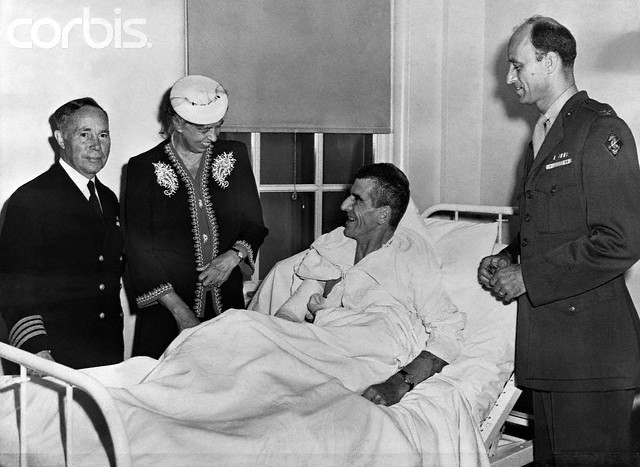
Eleanor Roosevelt Visiting Colonel Carlson at Naval Hospital
Original caption: Eleanor Roosevelt visits San Diego Naval Hospital. San Diego,
Calif.... Mrs. Eleanor Roosevelt learns first-hand details of the Battle for
Saipan from Lieut. Col. Evans F. Carlson, USMCR, famous Marine Raider leader,
during her visit to the San Diego Naval Hospital. With her are Capt. Morton D.
Willcutts (left), (MC) USN, and Col. James Roosevelt USMCR, who fought with
Colonel Carlson on Makin.
IMAGE: © Bettmann/CORBIS DATE PHOTOGRAPHED July 20, 1944
Stephenson was soon a close adviser to Roosevelt, and suggested that he put Stephenson's
good friend William J. "Wild Bill" Donovan in charge of all U.S.
intelligence services.
Donovan founded the U.S. Office of Strategic Services (OSS), which in 1947
would become the Central Intelligence Agency (CIA).
http://www.smokershistory.com/Donovan.htm
...
"Of such great influence was BSC's influence in the Roosevelt
administration that in 1941 it was able to design an American intelligence
counterpart, the United States Coordinator of Information, which became the
Office of Strategic Services the next year. The COI/OSS was created in the
'image and likeness of British Security Coordination.' Although officially
headed by William Donovan, Stephenson's assistant, Dick Ellis, did much
of the day-to-day running of the security agency, which was staffed by many
other British agents. Moreover, 'BSC passed on an attitude as much as it passed
on specific technical skills. It passed on a way of looking at problems and an
opnenness to possible solutions - no matter their legality or morality."
...
William J. Donovan / FBI FOIA file 1d (pdf)
"'Wild Bill' Donovan, the OSS chieftain, recruited many of the moles
into the OSS. This was not by carelessness. R. Harris Smith, in his book OSS:
The Secret History of America's First Central Intelligence Agency, revealed
that Donovan worked with Communist Party leader Eugene Dennis to recruit OSS
personnel from communist ranks. When confronted by the FBI with evidence that
some of his men were Communist Party members, Donovan replied, 'I know they're
Communists. That's why I hired them.'
Of course, when the CIA was organized in 1947, many of the OSS agents became CIA
agents." (The C.I.A., skull and bones, and rewriting history. By Warren
Mass. The New American, Feb. 19, 2007.)
http://www.spartacus.schoolnet.co.uk/USAdennisE.htm
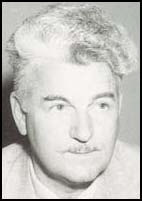
Francis Xavier Waldron (he later changed his name to Eugene Dennis)
was born in Seattle, Washington, on 10th August, 1905. He worked in various
trades and was active in the Industrial Workers of the World (IWW).
...
The prosecution also used the testimony of former members of the American
Communist Party to help show that Dennis and his fellow comrades had privately
advocated the overthrow of the government. The most important witness
against the leaders of the party was Louis Budenz, the former managing editor of
the party's newspaper, The Daily Worker.
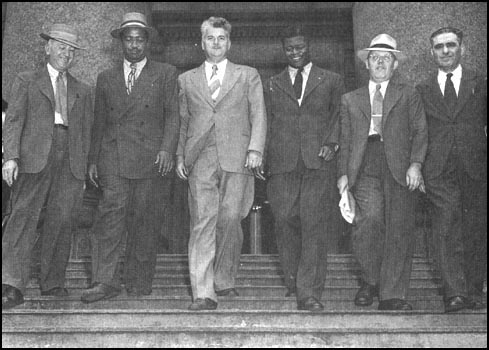
William Z. Foster, Benjamin Davis, Eugene Dennis, Henry Winston, John
Williamson and Jacob Stachel leaving the courthouse in New York (21st July,
1948)
Donovan
worked with Communist Party leader Eugene Dennis to recruit OSS personnel
Wedge:
from Pearl Harbor to 9/11 : how the secret war between the FBI and the CIA...
By Mark Riebling
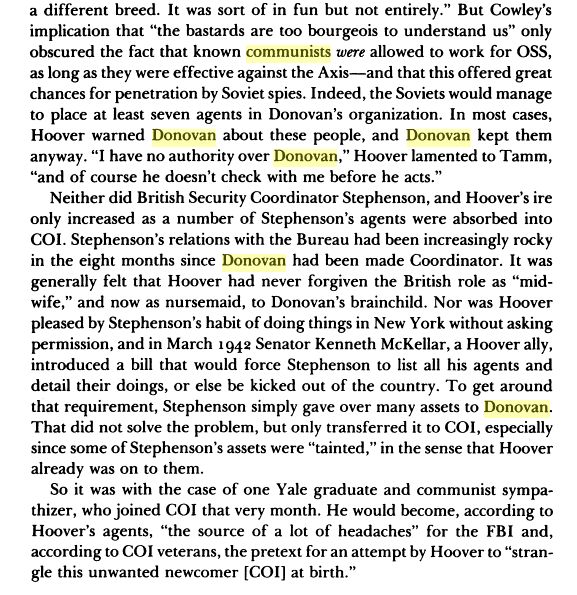
FOIA - FBI - William Donovan:
http://vault.fbi.gov/William%20J%20Donovan
http://vault.fbi.gov/William%20J%20Donovan%20/William%20J%20Donovan%20Part%201%20of%207/view
http://www.dispatch.com/live/content/arts/stories/2011/02/27/fdrs007.html?sid=101
Fearless 'Wild Bill' Donovan ran wartime agency that evolved into CIA
Sunday, February 27, 2011 02:59 AM By Jerry Harkavy
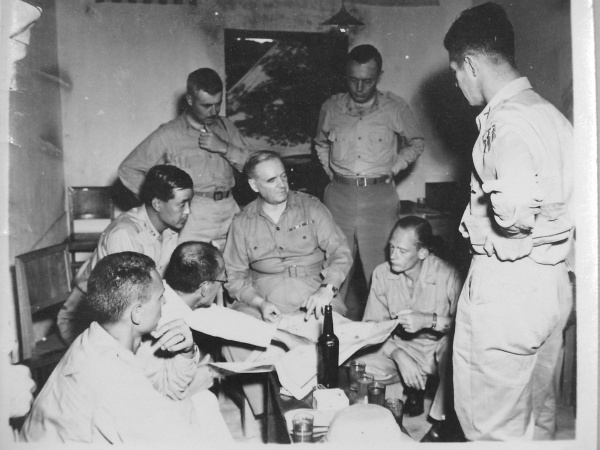
William Donovan, center, conferring in Xi'an, China, on plans for the
Office of Strategic Services during World War II
...
A hawkish conservative during the postwar years, Donovan became ambassador to
Thailand, where his mission of stemming communist advances in Southeast Asia
landed him in the emerging troubles of what, a decade or so later, became
America's all-consuming quagmire, Vietnam.
http://www.vanityfair.com/culture/features/2011/03/wild-bill-donovan201103?currentPage=2
Spymaster General
...
Stephenson was, secretly, a spy for M.I.6, who went by the code name
“Intrepid.” At some point Stephenson revealed his double life to
Donovan—and implored him to join the fight against the Axis. On July 14, 1940,
Donovan flew to London to meet Colonel Stewart Menzies, the chief of M.I.6,
known to his fellow spies simply as “C.” Donovan met “C” at M.I.6 headquarters
in an old Victorian manse on London’s Broadway, where the porters wore brass
buttons engraved with the motto on the royal coat of arms, “Honi soit qui mal
y pense” (“Evil be to him who evil thinks”). British intelligence should
“bare their breast” to Donovan, Stephenson had cabled Menzies. Donovan was
shown the inner workings of the British war effort and invited to dine with King
George VI.
...
In his memoirs, Stephenson suggested that Donovan was in fact a British
secret agent, recruited as early as World War I, but Stephenson was not
above exaggeration. The official C.I.A. history of the O.S.S., unsurprisingly,
rejects the charge. I asked William vanden Heuval, who as a young lawyer had
worked closely with Donovan and knew him well, whether he thought Donovan had
grown a little too close to Great Britain in 1940–41. Sitting in his Park
Avenue office, vanden Heuval, 79, insisted that Donovan may have liked English
clothes and manners, but he owed no fealty, secret or otherwise, to the British.
“I don’t think he was an Anglophile,” said vanden Heuval. “He was Irish.
He was an Irish warlord. He could command loyalty, like Bobby Kennedy,”
for whom vanden Heuval also worked. “He wouldn’t ask others to do what he
wouldn’t do and they knew it. He lived on the cusp of danger.”
(fyi - The "FitzGeralds (Sons of Gerald)" are
Welsh-Anglo-Norman's the conquerors of Ireland in 1169" )
http://en.wikipedia.org/wiki/Beekman_Place_(Manhattan)

...the luxurious sixteen-story co-op at 1 Beekman, built in 1930 by a syndicate
headed by David M. Milton, the son-in-law of John D. Rockefeller Jr.
Milton's wife, Abby, was called by The New York Times 'the wealthiest young
woman in America.'...
Early tenants at 1 Beekman included the diplomat David K. E. Bruce, William
J. Donovan - who founded the Office of Strategic Services, the forerunner of the
CIA - the Miltons, and John D. Rockefeller III."
Beekman Place is a small street located on the east side of Manhattan,
New York City.
...
The British made their headquarters in the mansion for a time during the
Revolutionary War and Nathan Hale was tried as a spy in the mansion's greenhouse
and hanged in a nearby orchard. George Washington visited the house many
times during his presidency.
...
One Beekman Place the 1929 co-op, designed by Sloan & Robertson and
Corbett, Harrison & MacMurray, is "the most prestigious Beekman Place
apartment building," according to Carter Horsley. It was built by a
group headed by David Milton, husband of Abby Rockefeller and son-in-law of John
D. Rockefeller, Jr. Early tenants here included "Wild Bill"
Donovan of the OSS and John D. Rockefeller III and A&P Heir Huntington
Hartford. Happy Rockefeller lived at One Beekman Place. It has a lavish
tiled pool on the ground floor for the tenants and a basketball court and small
ping pong table.
In the Movie Auntie Mame. Auntie Mame played by Rosalind Russell lives at
Beekman Place. In the Movie Bonfire of the Vanities based on Tom Wolfe's
book, the Mayor mentions Beekman Place. The Mayor in Bonfire of the Vanities
says "They sit in their co-ops, Park Avenue, Fifth, Beekman Place, snug
like a bug. Twelve-foot ceilings, a wing for them, one for the help".

OSS Col. David Bruce, later JFK's ambassador to the Court of St. James,
and NANA newspaper correspondent Ernest Hemingway shortly before entering
Paris and liberating the bar at the Hotel Ritz. [Photo from the book
OSS - by Smith]
Oh fyi - David Bruce was a
Bilderburger - See: Bilderberger's
in the Kennedy Administration

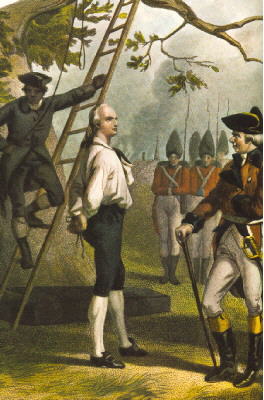
“I only regret that I have but one life to give my country.”
Nathan Hale was born
in Connecticut and attended
Yale before becoming a schoolteacher...
He volunteered for an intelligence-gathering mission in New York City but was
captured by the British.
According to a NY Historical Society plaque on the West side of Third Avenue
between 65th and 66th Streets, Nathan Hale, the American Revolutionary war
hero, was hanged by the British, “probably within a hundred yards of here.”
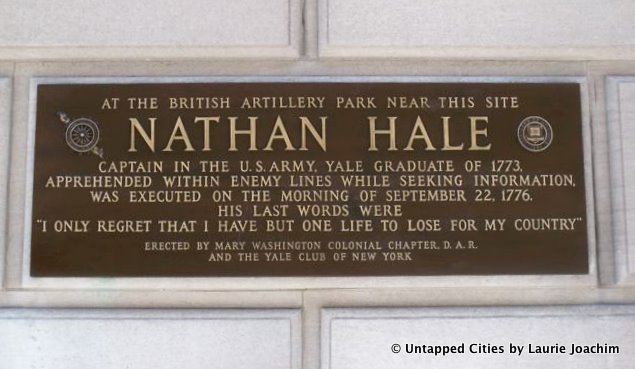
One plaque is hidden away on Vanderbilt Avenue next to Grand Central. It is
located on the façade of the Yale Club building, which of course, is
apropos since Nathan was an alumni.
The other plaque is located on a building now that now houses a Banana Republic
on 3rd Avenue and 65th Street.
 The
Yale Club of New York City, commonly called the Yale Club
The
Yale Club of New York City, commonly called the Yale Club
http://www.yaleclubnyc.org/Default.aspx?p=DynamicModule&pageid=271249&ssid=140906&vnf=1

Just steps from Grand Central Station, The Yale Club of New York City was
designed in 1915 by James Gamble Rogers, architect of Yale’s Sterling Memorial
Library as well as the Harkness Quad and Tower ...impressive 22-story
neoclassical clubhouse and 11,000 members,
The Yale Club of New York City is unquestionably the largest private club in
the world. However, the minute you arrive at 50 Vanderbilt, and enter
the first-floor lobby, you’ll be struck by the warm, welcoming intimacy of the
place:
friendly faces and fresh-cut flowers everywhere, and comfortable spaces where
you can re-energize, relax, and
meet friends er ... spies.
FYI ... In Marathon Man - Roy Scheider plays a Yale/CIA guy and he gets
together with his brother (Dustin Hoffman) at the Yale Club in NYC:
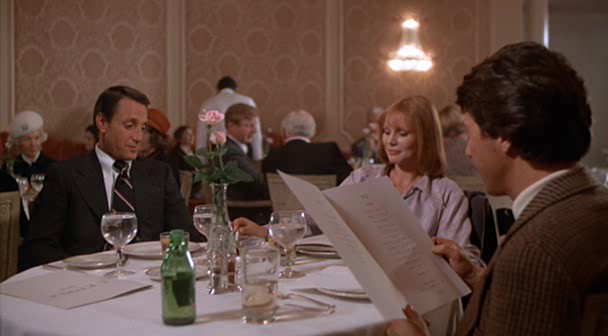
Venona:
decoding Soviet espionage in America By John Earl Haynes, Harvey Klehr
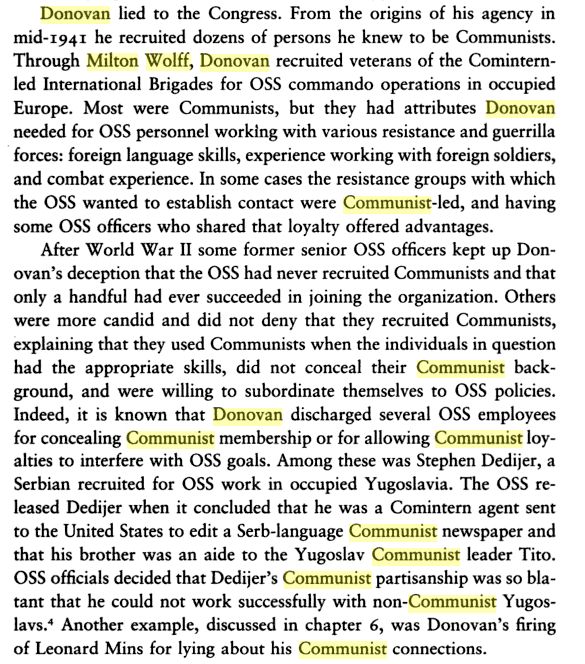

http://www.telegraph.co.uk/news/worldnews/northamerica/usa/3869117/General-George-S.-Patton-was-assassinated-to-silence-his-criticism-of-allied-war-leaders-claims-new-book.html
...
The death of General Patton in December 1945, is one of the enduring mysteries
of the war era. Although he had suffered serious injuries in a car crash in
Manheim, he was thought to be recovering and was on the verge of flying home.
But after a decade-long investigation, military historian Robert Wilcox
claims that OSS head General "Wild Bill" Donovan ordered a highly
decorated marksman called Douglas Bazata to silence Patton, who gloried in
the nickname "Old Blood and Guts".
His book, "Target Patton", contains interviews with Mr Bazata,
who died in 1999, and extracts from his diaries, detailing how he staged the car
crash by getting a troop truck to plough into Patton's Cadillac and then shot
the general with a low-velocity projectile, which broke his neck while his
fellow passengers escaped without a scratch.
Mr Bazata also suggested that when Patton began to recover from his injuries, US
officials turned a blind eye as agents of the NKVD, the forerunner of the KGB,
poisoned the general.
...
http://www.darkdemonscrygaia.com/showthread.php?t=10253&page=2

The founding fathers of the CIA William "Wild Bill" Donovan and
Allen Dulles were knights, as were many other CIA hierarchy including Ronald
Reagan’s director William Casey and JFK’s director John McCone.
In July 1944 Pope Pius XII awarded Donovan the 'Grand Cross of the Order of
St. Sylvester', one of the oldest and most prestigious of papal knighthoods,
and the highest Catholic award ever received by an American. Less than one
hundred men have received this award throughout history.
Related: Secret
report that shows how the Nazis planned a Fourth Reich ...in the EU
Patton and the missing and found Nazi gold:
http://www.channel4.com/history/microsites/H/history/i-m/lastdays3.html
...
On 3 February 1945, 937 B-17 bombers of the US 8th Air Force dropped nearly
2,300 tons of bombs on Berlin, causing the near demolition of the Reichsbank,
including its presses for printing currency.
Following the raid, Walter Funk, president of the Reichsbank, decided to send
most of the gold reserves, worth some $238 million, and a large quantity of the
monetary reserves to Wintershal AG's Kaiseroda potassium mine at the village of
Merkers, about 200 miles south-west of Berlin, for safekeeping.
...
The chief of staff of General Dwight D Eisenhower, the Allied commander, would
later estimate that the value of the gold, silver, and currency was over $520
million.
Patton, Eisenhower and Bradley
On 12 April [1945], the mine and its treasure were visited by Patton,
Eisenhower and General Omar Bradley, commander of the US 12th Army Group.
[Oh and Patton would be dead by December 21 1945... ]
 Target:
Patton: The Plot to Assassinate General George S. Patton - Robert K. Wilcox
Target:
Patton: The Plot to Assassinate General George S. Patton - Robert K. Wilcox
Target
Patton
General George S. Patton was assassinated to silence his criticism of allied
war leaders claims new book
George S. Patton, America's greatest combat general of the Second World War, was
assassinated after the conflict with the connivance of US leaders,
according to a new book.
By Tim Shipman in Washington 7:16PM GMT 20 Dec 2008
The newly unearthed diaries of a colourful assassin for the wartime Office of
Strategic Services (OSS), the forerunner of the CIA, reveal that American
spy chiefs wanted Patton dead because he was threatening to expose allied
collusion with the Russians that cost American lives.
....
His book, "Target Patton", contains interviews with Mr Bazata,
who died in 1999, and extracts from his diaries, detailing how he staged the car
crash by getting a troop truck to plough into Patton's Cadillac and then shot
the general with a low-velocity projectile, which broke his neck while his
fellow passengers escaped without a scratch.
Mr Bazata also suggested that when Patton began to recover from his injuries, US
officials turned a blind eye as agents of the NKVD, the forerunner of the KGB,
poisoned the general.
Mr Wilcox told The Sunday Telegraph that when he spoke to Mr Bazata:
"He was struggling with himself, all these killings he had done. He
confessed to me that he had caused the accident, that he was ordered to do so by
Wild Bill Donovan.
"Donovan told him: 'We've got a terrible situation with this great
patriot, he's out of control and we must save him from himself and from ruining
everything the allies have done.' I believe Douglas Bazata. He's a sterling
guy."
Mr Bazata led an extraordinary life. He was a member of the Jedburghs,
the elite unit who parachuted into France to help organise the Resistance in the
run up to D-Day in 1944. He earned four purple hearts, a Distinguished Service
Cross and the French Croix de Guerre three times over for his efforts.
After the war he became a celebrated artist who enjoyed the patronage of
Princess Grace of Monaco and the Duke and Duchess of Windsor.
He was friends with Salvador Dali, who painted a portrait of Bazata as Don
Quixote.
He ended his career as an aide to President Ronald Reagan's Navy Secretary
John Lehman, a member of the 9/11 Commission and adviser to John McCain's
presidential campaign.
Mr Wilcox also tracked down and interviewed Stephen Skubik, an officer in the
Counter-Intelligence Corps of the US Army, who said he learnt that Patton was on
Stalin's death list. Skubik repeatedly alerted Donovan, who simply had him sent
back to the US.
"You have two strong witnesses here," Mr Wilcox said. "The
evidence is that the Russians finished the job."
The scenario sounds far fetched but Mr Wilcox has assembled a compelling case
that US officials had something to hide. At least five documents relating to the
car accident have been removed from US archives.
The driver of the truck was whisked away to London before he could be
questioned and no autopsy was performed on Patton's body.
With the help of a Cadillac expert from Detroit, Mr Wilcox has proved that
the car on display in the Patton museum at Fort Knox is not the one Patton was
driving.
"That is a cover-up," Mr Wilcox said.
George Patton, a dynamic controversialist who wore pearl handled revolvers on
each hip and was the subject of an Oscar winning film starring George C. Scott,
commanded the US 3rd Army, which cut a swathe through France after D-Day.
But his ambition to get to Berlin before Soviet forces was thwarted by supreme
allied commander Dwight D. Eisenhower, who gave Patton's petrol supplies to the
more cautious British General Bernard Montgomery.
Patton, who distrusted the Russians, believed Eisenhower wrongly prevented him
closing the so-called Falaise Gap in the autumn of 1944, allowing hundreds of
thousands of German troops to escape to fight again,. This led to the deaths of
thousands of Americans during their winter counter-offensive that became known
as the Battle of the Bulge.
In order to placate Stalin, the 3rd Army was also ordered to a halt as it
reached the German border and was prevented from seizing either Berlin or
Prague, moves that could have prevented Soviet domination of Eastern Europe
after the war.
Mr Wilcox told The Sunday Telegraph: "Patton was going to resign from the
Army. He wanted to go to war with the Russians. The administration thought he
was nuts.
"He also knew secrets of the war which would have ruined careers.
I don't think Dwight Eisenhower would ever have been elected president if Patton
had lived to say the things he wanted to say." Mr Wilcox added: "I
think there's enough evidence here that if I were to go to a grand jury I could
probably get an indictment, but perhaps not a conviction."
Charles Province, President of the George S. Patton Historical Society, said he
hopes the book will lead to definitive proof of the plot being uncovered. He
said: "There were a lot of people who were pretty damn glad that Patton
died. He was going to really open the door on a lot of things that they screwed
up over there."
The
Rising Beast By Gerald Flurry
What has happened in former Yugoslavia over the past several years reaches far
beyond the boundaries of that region. It is so shocking that the nations of this
world would be paralyzed with fear if they truly understood! Shamefully, America
is its chief architect.
pps.28-31pdf
Published in the book "The Rising Beast Germany in the Balkans" by
Gerald Flurry
SUBJECT: Plans of German industrialists to engage in underground activity after
Germany’s defeat; flow of capital to neutral countries.
related thread: General
Patton Asassinated To Keep Him Quiet
Bazata - He ended his career as an aide to President Ronald Reagan's Navy
Secretary John Lehman, a member of the 9/11 Commission and adviser to John
McCain's presidential campaign.
http://en.wikipedia.org/wiki/John_Lehman
John F. Lehman, Jr. (born September 14, 1942) is an American investment
banker and writer who served as Secretary of the Navy in the Reagan
administration and in 2003-4 was a member of the 9/11 Commission.
He was also involved in the Project for the New American Century, that
claimed the absence of a "catastrophic and catalyzing event - like a new
Pearl Harbor" in the document "Rebuilding America´s
Defenses", which was released in September 2000. His most famous quote
according to NNDB is: "Power corrupts. Absolute power is kind of
neat."
related see above Target Patton - Douglas DeWitt Bazata Obit 1999
http://www.nytimes.com/1999/08/22/world/douglas-dewitt-bazata-artist-and-oss-officer-dies-at-88.html
Douglas DeWitt Bazata, Artist And O.S.S. Officer, Dies at 88
By ERIC PACE
Published: August 22, 1999
Douglas DeWitt Bazata, who served with the United States Office of Strategic
Services behind enemy lines in France in World War II and later became an
artist, died on July 14 in his home in Chevy Chase, Md. He was 88.
The death of Mr. Bazata was belatedly reported to The New York Times.
He was described as ''a red-haired soldier of fortune who called all colonels
'Sugar' '' in a 1978 book, ''Honorable Men,'' by William E. Colby, a former
Director of Central Intelligence, and Peter Forbath.
Mr. Bazata had already served in the Marines and was a skilled boxer and
marksman when he became an Army officer in 1942 and also joined the O.S.S.,
the forerunner of the Central Intelligence Agency.
He went on to be one of a daring group of about 50 American parachute
officers who volunteered for what Mr. Colby described as ''a highly hazardous
mission'' in Nazi-occupied France, Belgium and the Netherlands.
Other members of the group included Stewart Alsop, later a noted
journalist, and Mr. Colby.
http://www.robertkwilcox.com/article-patton2010.html
WAS GEN. PATTON ASSASSINATED?CONTROVERSY
By Robert K. Wilcox:
...
Douglas Bazata was the first of these two witnesses to go public. An
Office of Strategic Services (OSS) “Jedburgh” in World War II, the
forerunners of US Special Forces, he claimed that as an OSS assassin, he was
asked to kill Patton by OSS chief Gen. William“Wild Bill” Donovan. The order
was the culmination of a long-running plot during the war that had started as a
non-lethal “stop Patton” plan. Later, in interviews with me, he enlarged
that scenario, claiming that he, along with an NKVD (Russian military
intelligence) accomplice, set up the December 9 “accident,” and that others
– he believed the Soviets – had completed the task in the hospital.
It is not well known except amongst certain historians that Donovan forged a
cooperating alliance between the OSS and NKVD, beginning in 1943. And
despite the fact that he was sometimes played for a fool by the Russians,
whose spies already riddled the OSS (and therefore the NKVD did not need the
cooperation), he continued working with them throughout the war and after.
The other witness was Stephen J. Skubik, a Counter Intelligence Corps (CIC)
agent attached until war’s end to Patton’s armies. Afterward he
continued working as a CIC agent among Soviet-dominated Ukrainians whom, he
said, warned him that Stalin had put Patton on an NKVD hit list.
Skubik, who wrote a privately-printed book entitled, The Murder of General
Patton, claimed three top Ukrainians – Gen. Pavlo Shandruk, Prof. Roman
Smal-Stocki, and the Ukrainian nationalist leader Stepan Bandera – each
separately warned him that Patton was marked for murder. But when he
reported the plot to Wild Bill Donovan himself, instead of being grateful,
Donovan had him jailed. Following Patton’s death, Skubik was forced to flee
Germany for fear of being murdered himself. For several years he lived in hiding
in America.
These two witnesses are highly credible. Their stories mesh without either
having known about the other. Bazata, who left the army as a major, was one
of the most decorated Jedburghs, having jumped into, among other harrowing
missions, Nazi-occupied France to help organize local resistance in preparation
for D-Day. He spent 25 years after WWII in Europe as a clandestine, was a
good friend of fellow Jedburgh and ex-CIA director William Colby, and ended his
career as an aide to Secretary of the Navy John Lehman during the Reagan
Administration.
Skubik, after emerging from hiding, rose to a top managerial position in the
Prudential Insurance Company in Washington D.C., and aided Republican presidents
from Eisenhower through Reagan as an expert on Eastern European affairs. I
vetted both men extensively through secret documents at places like the National
Archives and through interviews with those who knew them. They both died in the
1990s. But if this case were ever brought to a grand jury, their preserved
testimony, I believe, would be enough to get an indictment.
Even without such testimony, Patton’s death remains an unsolved mystery. In
the months before he died, for instance, he was involved in at least two other
highly suspicious accidents.
On May 3, 1945, Patton was almost decapitated when a farmer’s wagon with
some sort of scythe-like instrument protruding from it suddenly rolled out
unattended from a side street towards his passing jeep and “missed us only by
about an inch,” he wrote in his diary.
The other “accident,” just a few weeks before, on April 10, 1945, is
even more suspicious. Patton was visiting units in his light observation
plane when four Polish Spitfires supposedly mistook his tiny aircraft for a Nazi
fighter and attacked it. While three circled and acted almost as lookouts,
the fourth Spitfire made repeated attacks. If not for the ground hugging and
evasion skills of Patton’s pilot, the general surely would have been killed.
As it was, the attacking Spitfire couldn’t pull up after one of its steep
diving attacks and crashed. The Russians by that time controlled Poland. Patton
was livid, and an aide accompanying him in the plane vowed to find out what
happened. But to this day, there is scant information about the attack beyond
what both wrote in their diaries.
http://www.specialforcesroh.com/browse.php?mode=viewawards&sort=n&catid=42&page=1
JEDBURGH - Jedburgh Teams (BCRA,OSS,SOE)
Douglas DeWitt (Doug) Bazata
OSS Jedburgh Team Cedric
Distinguished Service Cross,Croix de Guerre with 2 palmes (Fr),Croix de Guerres
with gold star (Fr),Purple Heart
born 17.2.1911 Wrightsville,Pennsylvania
educated Syracuse University
USMC 1933-37
commissioned US Army 1942
codename Vesdre
WIA 1944
left Army 1947 as Major
married Diana Chirieleison 1943 (divorced)
married Penelope Grant 1948 (divorced)
married Marie-Pierre 1970
father of Nicholas of Northumberland,England
artist postwar
died 14.7.1999 Chevy Chase,Maryland
Arlington National Cemetery,Virginia Section 66 Site 793
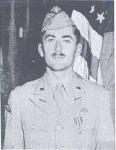 Colby
Colby
William Egan (Bill) Colby - for biography see OSS Awards
OSS Jedburgh Team Bruce
The
Jedburghs: The Secret History of the Allied Special Forces, France 1944
[Hardcover] Will Irwin
http://www.nps.gov/history/history/online_books/oss/
OSS Training in the National Parks and Service Abroad in World War II
By John Whiteclay Chambers II 2008
U.S. National Park Service
Washington, D.C.
http://www.nps.gov/history/history/online_books/oss/chap8.pdf
OSS in Action: The Mediterranean and European Theaters
OSS casualties in France
Of the 83 American Jedburghs, 5 were killed in action, 6 percent, almost double
the 3 ½ percent overall death rate; 3 were missing or captured; and 6 were
wounded
...
Captain Douglas (“Doug”) DeWitt Bazata, head of Team Cedric in eastern
France was badly wounded in action
...
Major William E. Colby, who would later become head of the CIA under
Presidents Richard Nixon and Gerald Ford, was an “Army Brat,” born in
St. Paul, Minnesota, and raised at military facilities around the world,
including China. On a
scholarship, he went to Princeton University, spent a summer in France, and
obtained a commission through Army ROTC. He had just finished his first year at
Columbia Law School, when he was called to active duty in 1941. Bored with the
field artillery, he joined the paratroops, from which OSS recruited him in
September 1943. By December, the 23-year-old paratroop officer had completed SO
training at Areas F and B and was bound for England as a Jedburgh.151 The youthful,
scholarly looking major was assigned to head Jed Team “Bruce” with two
French soldiers. Their mission was to aid the French Resistance in the Yonne
Valley some sixty miles southeast of Paris.
Instead of being dropped into a rural area, the plane on a mid-August night,
dropped them right into the
center of a German-occupied town. The falling supply containers woke up the
townspeople as well as the Germans, and the Jedburgh team had to dodge patrols
for two days until they were able to reach the maquis. Although it was later
discovered that the local Resistance had been run by a collaborator working with
the Germans, by August
1944, Colby realized the Nazis would be defeated and he did not endanger the
Jeds.
Douglas DeWitt Bazata - After the war he became a celebrated artist
who enjoyed the patronage of Princess Grace of Monaco and the Duke and
Duchess of Windsor
Remember the Duke and Duchess of Windsor were Nazi's....
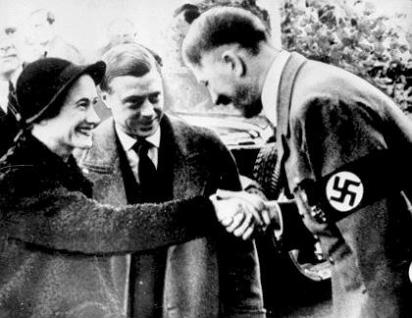
The Nazi Gold Patton found (there was more):

http://www.warbirdforum.com/roster6.htm
Roster of the 2nd AVG
The 2nd AVG was a bomber
group, authorized by President Roosevelt and recruited by Bill Pawley's
Central Aircraft Manufacturing Company in the fall of 1941.
CAMCO hired 82 pilots and 359 ground crew (almost certainly including air
crew) who were duly discharged from the U.S. Army in November 1941. Lockheed
outfitted 33 Hudson bombers--really little more than a militarized version of
the Lockheed Super Electra transport, complete with the passenger windows--with
long-range fuel tanks so they could fly across the Pacific; they were
to have been used for
"occasional incendiary bombing of Japan". The same number
of Douglas Boston light bombers (A-20s in U.S. service) would travel by sea to
Africa, and there be assembled for the flight overland through India to China.
A considerable group sailed from California on November 21 aboard
Bloemfontein and possibly Noordam, which had earlier carried men of the 1st AVG
to Burma. Sergeants Charland, Zimmerman, and Brogden, plus the adaptible
"Jimmy" Stewart, must have been among them.
Following the Japanese breakout on December 7/8, the ships were diverted to
Australia, where Bloemfontein docked on December 22, and where the army men
were eventually taken back into U.S. service. Their Douglas and Lockheed bombers
were likewise re-inducted, as were the men who hadn't yet sailed for Asia. I'm
seeking the names of those with a connection with the 2nd AVG. If you know of
any such, please send email. And click here for more about the 2nd AVG.
It is interesting - I just saw "God is my co-pilot" where in the movie
the speak about the AVG getting bombers to be used in bombing Japan but the
context was after Pearl Harbor (stating the Philippine air bases were already
lost). in the movie they get the bombers and use them to bomb Japanese
controlled Hong Kong.
http://en.wikipedia.org/wiki/Flying_Tigers
One of the pilots drawn to the success of the AVG was Robert Lee Scott, Jr.
who was flying supplies into Kunming over the Hump from India. He convinced
Chennault to loan him a P-40 which he flew to protect the supply route; his
aggressiveness led to Chennault's recruiting him as commander of the 23rd
Fighter Group. Scott brought recognition to his exploits and the Flying
Tigers with his best selling book God is My Co-pilot that was also made into
a popular movie.
God is My Co-pilot, (1943, with Dennis Morgan as Robert Lee Scott,
Raymond Massey as Chennault, and John Ridgely as Tex Hill);
http://www.warbirdforum.com/fdrnote.htm
FDR's 'secret order'
The Flying Tiger romances all speak of a "secret executive order"
supposedly signed by President Roosevelt to create the American Volunteer Group.
No such order has ever surfaced, and Roosevelt historians agree that it wouldn't
have been his style: he preferred to give a wink and a nod, and to leave the
details to his subordinates-- Lauchlin Currie , in this case.
This is the closest I could come: notes written at Currie's request to direct
the armed forces to release men for the 2nd and 3rd AVG, a bomber group and a
fighter group, respectively. Since the navy was particularly reluctant to
release men in 1941, Currie worked out a plan whereby the 2nd AVG would be
recruited entirely from the U.S. Army in the fall of 1941, and the 3rd--a
fighter group equipped with P-43 Lancers and P-66 Vanguards--from the navy
starting in January. Below is FDR's directive to the Secretary of the Navy
with respect to the 3rd AVG:
[ this is "Roosevelt adviser and NKVD agent Lauchlin Currie"
mentioned in previous posts ! ]
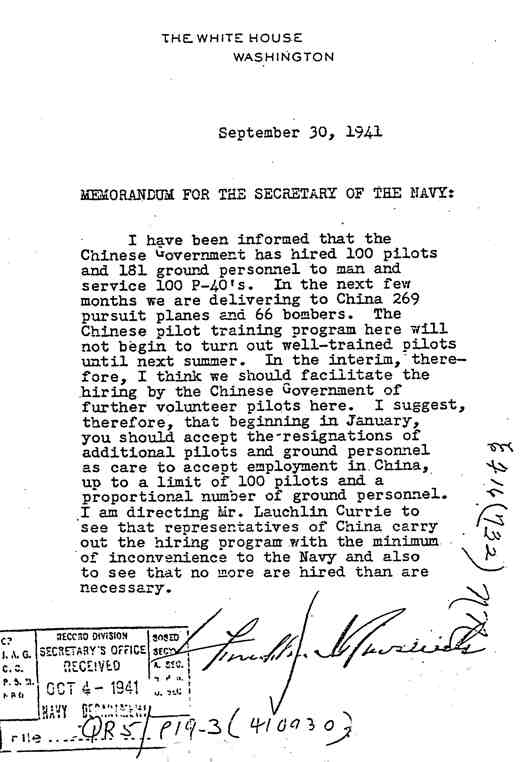
[Supplied by Alan Armstrong. Another copy is in the Roosevelt Library at Hyde
Park, New York.]
Again we see that FDR had intentions of attacking Japan in Dec41/January
1942 under the China flag - but the orders were broadcasted to Russian agents (
via NKVD agent Lauchlin Currie ) that told the Japanese (via spies in
China and the IPR ) and cemented their intentions to attack Pearl Harbor,
beating the U.S. to the punch.
[ Again Hitler's plan was for the Japanese to attack the U.S.S.R. and the
soviet spies job was to direct them elsewhere.... ]
http://www.warbirdforum.com/b25s.htm
...
[Bob Klemann graduated from flight training with Class 41B at Randolph/Kelly
Field, Texas.
He was sent to McChord Field to train as a bomber pilot.
In September 1941 he was
recruited for the 2nd American Volunteer Group, to fly Lockheed Hudson
bombers attacking Japanese positions in China and perhaps to bomb the
Japanese home islands.
In December he was flying from Sacramento to San Francisco to sail to the Far
East when he heard about the Pearl Harbor attack on the plane's radio. The
2nd AVG was aborted and he returned to U.S. service. -- Dan Ford]
Preemptive
strike: the secret plan that would have prevented the attack on Pearl Harbor. By
Alan Armstrong 2006
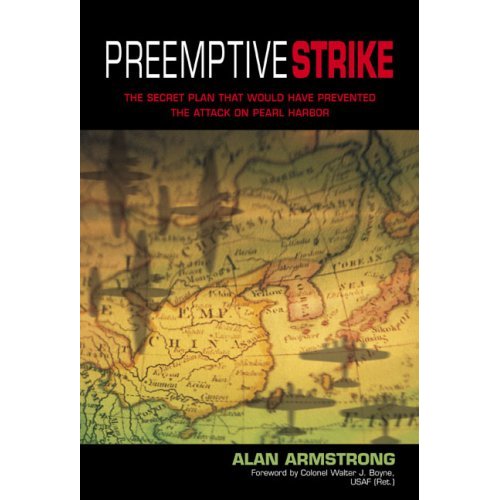
More Soviet spies - The Silvermaster Group - Duncan Chaplin Lee - which
connects Currie to Donovan and China...
Oh and he becomes AIG's lawyer....
http://education-research.org/CSR/Holdings/Soviet/NKVD.htm
335-page report on information furnished by Elizabeth Bentley (“Gregory”)
and follow-up through FBI surveillance concerning the Silvermaster Group, (Lauchlin
Currie, Harry Dexter White, etc.), the Perlo Group (Alger Hiss, etc.), and
others. Discusses contacts of Mary Jane Keeney with Joseph Bernstein, David
Wahl, Maurice Halperin, etc. Also includes intel on H. Bowen Smith, Duncan Lee,
Ruth Rifkin, Cedric Belfrage, Bernard Redmont, Peter Rhodes, et al. Table of
contents refers to some 56 principal suspects; index relates to hundreds of
other people. (Also appears as Volume 82 of the Silvermaster file.)
The Silvermaster Group
Nathan Gregory Silvermaster
Helen Witte Silvermaster, was
Schlomer Adler, was
Norman Chandler Bursler
Virginius Frank Coe
Lauchlin Bernard Currie
Bela Gold, was
Sonie Steinman Gold, was
Irving Kaplan
Abraham George Silverman
William Henry Taylor
William Ludwig Ullman
Anatole Boris Volkov
Harry Dexter White
http://en.wikipedia.org/wiki/FBI_Silvermaster_File
The FBI’s Silvermaster file[1] is a 162-volume compendium of some 26,000 pages
of documents relating to the Bureau’s investigation of Communist penetration
of the Federal government during the Cold War.
Beginning in 1945 with the allegations of defecting Soviet courier Elizabeth
Bentley (Venona cover names “Myrna”[2]; Umnitsa, “Clever Girl”[3]),
the file is also known as the Bentley file or Gregory file (“Gregory” being
the FBI’s code name for Bentley).
The file takes the name “Silvermaster” from Nathan Gregory Silvermaster (Venona
cover names Pel[4], Pal, “Paul”[5]; “Robert”[6]) of the War Production
Board, whom Bentley named as head of an underground Communist network known as
the Silvermaster Group.[7]
Among the people named in the file in connection with this group are
President Franklin Roosevelt’s Administrative Assistant Lauchlin Currie[8]
(Currie's Venona cover name was "Page")[9] and Assistant Secretary of
the Treasury Harry Dexter White[10] (Venona cover names “Lawyer”[11];
“Jurist”[9]; “Richard”[12]).
Also named in the file are Victor Perlo[13] (Venona cover name
“Raider”[14]), chief of the Aviation Section of the War Production Board,
and contacts of his Perlo group, including Alger Hiss[15] (Venona cover name
“Ales”[16][17][18]), secretary general of the United Nations Charter
Conference. (Like several others identified by Bentley, Hiss had been identified
independently by another defecting Soviet courier, Whittaker Chambers, to
Assistant Secretary of State Adolf Berle in 1939.[19]) Among dozens of others
named by Bentley in this file in connection with this network is Duncan Lee[20]
(Venona cover name “Koch”[21]), confidential assistant to William
Donovan, founder and director of the Office of Strategic Services (OSS), wartime
predecessor of the CIA.
http://en.wikipedia.org/wiki/Duncan_Lee
Lt. Col. Duncan Chaplin Lee (died 1988) was confidential assistant to Maj.
Gen. William ("Wild Bill") Donovan, founder and director of the
Office of Strategic Services (OSS), World War II-era predecessor of the CIA,
during 1942-46. Lee is identified in Venona as the Soviet double agent
operating inside OSS under the cover name "Koch,"[1] making him
the most senior alleged source the Soviet Union ever had inside American
intelligence.
As an OSS officer, Lee served as head of the China section of SI, the Secret
Intelligence Branch.[2] While an officer, according to Soviet courier
Elizabeth Bentley, Lee -- reportedly a descendant of Confederate Gen. Robert
E. Lee[3] -- covertly furnished her with information on “anti-Soviet work
by OSS” and other topics of interest to Moscow,[4] which was technically an
ally (in Europe) following the collapse of the Nazi-Soviet pact. As Bentley told
the FBI when she defected in 1945, she transferred this information to her
Soviet handlers
...
Lee, a former Rhodes scholar who attended Oxford University with
fellow OSS staffer Donald Niven Wheeler (identified in Venona as the Soviet
agent operating in OSS under cover name "Izra"[7])
...
A 1944 Venona decrypt confirms that Lee tipped off Bentley about Donovan sending
him on a secret mission to China
...
Lee went on to have a successful career as a lawyer in the private sector[21].
Lee continued to represent clients such as Claire Chennault and Whiting
Willaurer.
In 1949, following the fall of China to the communists, Lee represented a
CIA-front company in the Hong Kong and UK courts in a successful effort to keep
a large fleet of transport aircraft in Hong Kong, once owned by the
Nationalist Chinese government, from being turned over to the new communist
Chinese regime after its recognition by the British.[22]
Lee joined insurance giant American
International Group in 1953, rising to serve as AIG’s chief in-house
lawyer in New York City prior to his retirement in 1974[23]. He subsequently
moved to Toronto with his Canadian wife, Frances Lee Smith, where he died in
1988[24].
http://www.conservapedia.com/Duncan_Lee
Duncan Chaplin Lee was a descendant of Confederate General Robert E. Lee and a
Rhodes Scholar. Lee attended college with Donald Wheeler. In the early summer
of 1942 Lee was appointed confidential assistant to William J. Donovan,
chief of the Office of Strategic Services (OSS). Lee became the NKVD’s most
senior source in American intelligence.
Lee was employed in the OSS from 1942 to 1946.
A Venona decrypt from June 1943 lists six Soviet agents working in the OSS and
the Office of War Information; five of the Soviet sources have been identified,
Maurice Halperin, Franz Neumann, Bella Joseph, Julius Joseph, and Duncan Lee.
Lee supplied the Soviet Union with a list of OSS employees suspected of being
Communists or Communist sympathizers and informed Moscow of the impending D-Day
invasion in 1944 and operations in China and Japan.
Decoded Soviet intelligence cables show Lee reporting on British and
American diplomatic strategy for negotiating with Stalin over postwar Poland,
American diplomatic activities in Turkey and Romania, and OSS operations in
China and France.
Lee was never indicted, and became a private sector lawyer after World War II.
He was Chief Counsel for American International Group before his retirement in
1974. He and his wife moved to Canada where he died in 1988.
Also see: Blacklisted
by History: The Untold Story of Senator Joe McCarthy By M. Stanton Evans
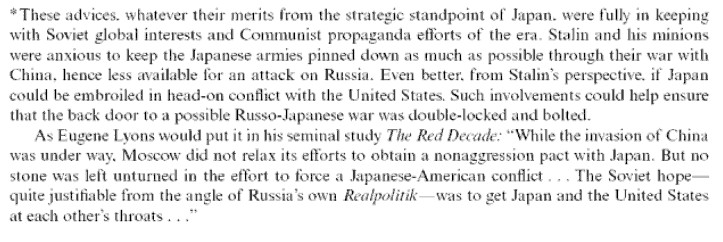
A very good article on the BSC...
http://www.spartacus.schoolnet.co.uk/SPYbsc.htm
British Security Coordination
Winston Churchill became prime minister in May 1940. Churchill realised straight
away that it would be vitally important to enlist the United States as Britain's
ally. Randolph Churchill, on the morning of 18th May, 1940, claims that his
father told him "I think I see my way through.... I mean we can beat
them." When Randolph asked him how, he replied with great intensity:
"I shall drag the United States in."
...
Churchill sent William Stephenson to the United States to make certain
arrangements on intelligence matters. Stephenson's main contact was Gene
Tunney, a friend from the First World War, who had been World Heavyweight
Champion (1926-1928) and was a close friend of J. Edgar Hoover, the head of the
FBI. Tunney later recalled: "Quite to my surprise I received a
confidential letter that was from Billy Stephenson, and he asked me to try and
arrange for him to see J. Edgar Hoover... I found out that his mission was so
important that the Ambassador from England could not be in on it, and no one in
official government... It was my understanding that the thing went off extremely
well." Stephenson was also a friend of Ernest Cuneo. He worked for
President Franklin D. Roosevelt and according to Stephenson was the leader of
"Franklin's brain trust". Cuneo met with Roosevelt and reported
back that the president wanted "the closest possible marriage between the
FBI and British Intelligence."
...
Churchill now instructed Stewart Menzies, head of MI6, to appoint William
Stephenson as the head of the British Security Coordination (BSC). Menzies
told Gladwyn Jebb on 3rd June, 1940: "I have appointed Mr W.S. Stephenson
to take charge of my organisation in the USA and Mexico. As I have explained to
you, he has a good contact with an official (J. Edgar Hoover) who sees the
President daily. I believe this may prove of great value to the Foreign Office
in the future outside and beyond the matters on which that official will give
assistance to Stephenson. Stephenson leaves this week. Officially he will go as
Principal Passport Control Officer for the USA."
...
Ian Fleming, Louis Mountbatten and James Roosevelt were visitors to the
British Security Coordination head office. Grace Garner recalls:
"Mountbatten would not come to the office frequently. Fleming came in from
time to time, and of course they were both so good-looking that just like
dominoes, the girls would go down - whoosh, like that.... James Roosevelt, the
president's son, did a few things in the way of propaganda for Britain, and he
appeared at meetings."
...
At the end of the Second World War the files of British Security Coordination
were packed onto semitrilers and transported to Camp X in Canada. Stephenson
wanted to have some record of the activities of the agency, "To provide a
record which would be available for reference should future need arise for
secret activities and security measures for the kind it describes." He
recruited Roald Dahl, H. Montgomery Hyde, Giles Playfair, Gilbert Highet and Tom
Hill, to write the book. Stephenson told Dahl: "We don't dare to do it in
the United States, we have to do it on British territory." Dahl commented:
"He pulled a lot over Hoover... He pulled a few things over the White
House, too, now and again. I wrote a little bit but eventually I called Bill and
told him that it's an historian's job... This famous history of the BSC through
the war in New York was written by Tom Hill and a few other agents." Only
twenty copies of the book were printed. Ten went into a safe in Montreal and ten
went to Stephenson for distribution.
http://en.wikipedia.org/wiki/Camp_X
...
Camp X was established December 6, 1941 by the chief of British Security
Coordination (BSC), Sir William Stephenson, a Canadian from Winnipeg, Manitoba,
and a close confidante of Winston Churchill and Franklin Delano Roosevelt.[1]
The camp was originally designed to link Britain and the United States at a time
when the US was forbidden by the Neutrality Act to be directly involved in
World War II.
Before the attack on Pearl Harbor and America's entry into the war, Camp X
opened for the purpose of training Allied agents from the Special Operations
Executive, Federal Bureau of Investigation, and American Office of Strategic
Services (OSS) intended to be dropped behind enemy lines as saboteurs and spies.
However, even before the United States entered the war on December 7, 1941,
agents from America's intelligence services expressed an interest in sending
personnel for training at the soon to be opened Camp X. Agents head of the OSS,
who credited Sir William Stephenson with teaching Americans about foreign
intelligence gathering. The CIA even named their recruit training facility
"The Farm", a nod to the original farm that existed at the Camp X site.
Camp X was jointly operated by the BSC and the Government of Canada.[1] The
official names of the camp were many: S 25-1-1 by the Royal Canadian Mounted
Police (RCMP), Project-J by the Canadian military, and Special Training School
103 by the Special Operations Executive, administered under the cover of the
Ministry of Economic Warfare [[MEW].
http://www.barnesandnoble.com/w/british-security-coordination-nigel-west/1015173876
British Security Coordination: The Secret History of British Intelligence in
the Americas, 1940-45 (used $70)
by Nigel West, Roald Dahl, Tom Hill, William Stephenson, Gilbert Highlet
Overview
In 1940 Winston Churchill dispatched a Canadian industrialist to New York
with an extraordinary mission in a neutral country: to set up a secret spy
network across both North and South America to cripple and confound Nazi
propaganda and to fan the flames of pro-war sentiment. Sir William Stephenson
(of A Man Called Intrepid fame) set up shop in Rockefeller Center to build a
vast intelligence network-the British Security Coordination-the full story of
which is now told for the first time. Operating on still-neutral soil,
Stephenson's people soon launched an astonishing bagful of dirty tricks: they
unmasked Axis spies, intercepted enemy communications, slipped beautiful female
spies into the Vichy and Italian embassies in Washington, infiltrated labor
unions, and spread British propaganda using U.S. radio stations and such
prominent journalists as Walter Winchell and Drew Pearson. The complete
report-commissioned at the end of the war and written by Roald Dahl and Gilbert
Highet, among others-has been kept secret until now.
David K. E. Bruce
- February 12, 1898 - December 5, 1977) was an American diplomat, and the only
American to serve as Ambassador to France, the Republic of Germany and the
United Kingdom.
On May 29, 1926,
Bruce married Ailsa
Mellon, the daughter of the banker
and diplomat
Andrew
W. Mellon.[2]
They divorced on April 20, 1945.
Their only daughter,
Audrey, and her husband, Stephen Currier, were presumed dead when a plane in
which they were flying in the Caribbean disappeared on January 17, 1967, after
requesting permission to fly over Culebra, a U. S. Navy installation. No trace
of the plane, pilot, or passengers was ever found. Audrey and Stephen Currier
left three children: Andrea, Lavinia, and Michael.
Bruce married
Evangeline Bell (1914–1995) on April 23, 1945, three days after his divorce.[2]
They had two sons and one daughter, Alexandra (called Sasha). She died under
mysterious circumstances (possibly murder or suicide) in 1975 at age 29 at the
Bruce family home in Virginia.[3][4]
During World War II,
he served with the Office
of Strategic Services operation in London and observed the invasion
of Normandy landing there the day after the initial invasion.
He served as the United
States Ambassador to France from 1949 to 1952, United
States Ambassador to West Germany from 1957 to 1959, and United
States Ambassador to the United Kingdom from 1961 to 1969.
He was an American
envoy at the Paris peace talks between the United States and North
Vietnam in 1970 and 1971.
Bruce also served as
the first United States emissary to the People's
Republic of China from 1973 to 1974.[5]
He was the ambassador
to the North Atlantic Treaty Organization from late 1974 to 1976.
Bruce was a candidate
for director of its successor the Central Intelligence Agency (CIA) in
1950.
He is said to have
written a secret report on the CIA for President Dwight
D. Eisenhower in 1956 that was highly critical of its operation under Allan
Dulles's leadership.[6]
Bruce purchased and
restored Staunton Hill, his family's former estate in Charlotte
County, Virginia. He received the Presidential
Medal of Freedom in 1976.
Bruce served as the
Honorary Chair on the Board of Trustees of the American
School in London during his diplomatic career in the United Kingdom. The
David K.E. Bruce Award was established in 2007 at the school.[7]
He died on December 5,
1977 of a heart
attack at Georgetown
University Medical Center.[
See also Spatacus:
David Bruce Biography
Bruce served in the United
States Army during the Second
World War. He was head of the Office
of Strategic Services (OSS) in London and in
1944 took part in the liberation of Paris. After the war he worked for the
European Cooperation Administration.
...
President Harry
Truman appointed Bruce as the US Ambassador to France (1949-52). According
to Evan Thomas (The Very Best Men) Bruce
discovered that the CIA
was involved in a plot to overthrow the government of Guatemala in 1952. Bruce
joined forces with the Secretary of State, Dean
Acheson, to persuade Truman that "overthrowing the duly elected
government of a Central American country would do more harm than good."
Bruce moved to Washington
where he associated with a group of journalists, politicians and government
officials that became known as the Georgetown
Set. This included Frank
Wisner, George
Kennan, Dean
Acheson, Richard
Bissell, Desmond
FitzGerald, Joseph
Alsop, Stewart
Alsop, Tracy
Barnes, Thomas
Braden, Philip
Graham, Clark
Clifford, Walt
Rostow, Eugene
Rostow, Chip
Bohlen, Cord
Meyer, James
Angleton, William
Averill Harriman, John
McCloy, Felix
Frankfurter, John
Sherman Cooper, James
Reston, Allen
W. Dulles and Paul
Nitze.
Most men brought their wives to these gatherings. Members of what was later
called the Georgetown Ladies' Social Club included Katharine
Graham, Mary
Pinchot Meyer, Sally Reston, Polly Wisner, Joan Braden, Lorraine Cooper,
Evangeline Bruce, Avis Bohlen, Janet Barnes, Tish Alsop, Cynthia Helms, Marietta
FitzGerald, Phyllis Nitze and Annie Bissell.
In 1956 President Dwight
Eisenhower appointed Bruce as a member of the President's Board of
Consultants on Foreign Intelligence Activities (PBCFIA). Eisenhower asked
Bruce to write a report on the CIA. It was presented to Eisenhower on 20th
December, 1956. Bruce argued that the CIA's covert actions were
"responsible in great measure for stirring up the turmoil and raising the
doubts about us that exists in many countries in the world today." Bruce
was also highly critical of Operation
Mockingbird. He argued: "what right have we to go barging around in
other countries buying newspapers and handling money to opposition parties or
supporting a candidate for this, that, or the other office."
Eisenhower appointed Bruce as US Ambassador to West Germany (1957-59).
He returned to office when President John
F. Kennedy made him Ambassador to Great Britain in 1961. He held the
post until the resignation of Lyndon
B. Johnson.
David Kirkparick Bruce died in 1977.


 BSC Nazi South America Map
BSC Nazi South America Map

 Stimson
had the Bomb
Stimson
had the Bomb Agnes Smedley(far
right) with her friends Mao Tsetung(left) and general Chu Teh in Yenan guerilla
base. 1937
Agnes Smedley(far
right) with her friends Mao Tsetung(left) and general Chu Teh in Yenan guerilla
base. 1937 Owen
Lattimore with Chiang Kai-shek in Chongqing in 1941
Owen
Lattimore with Chiang Kai-shek in Chongqing in 1941



 Sir William Samuel Stephenson
Sir William Samuel Stephenson








 MI-6
Charles "Dick" Ellis
MI-6
Charles "Dick" Ellis




 What
really happened - Honolulu Advertiser
What
really happened - Honolulu Advertiser LIFE
- Sept_1945 The Hull Note
LIFE
- Sept_1945 The Hull Note 9 Rockefeller Plaza
9 Rockefeller Plaza

 FDR
and son James
FDR
and son James


















 Target:
Patton: The Plot to Assassinate General George S. Patton - Robert K. Wilcox
Target:
Patton: The Plot to Assassinate General George S. Patton - Robert K. Wilcox
 Colby
Colby



